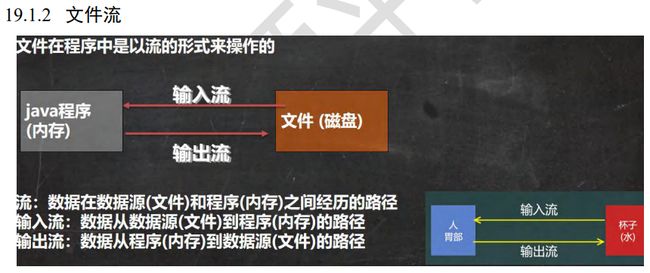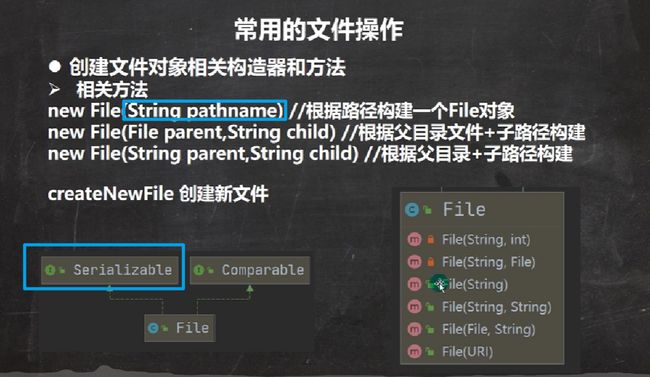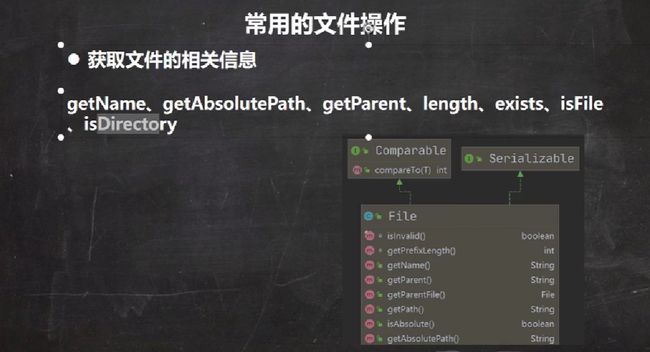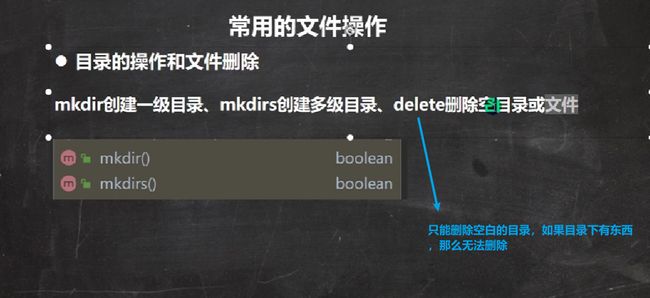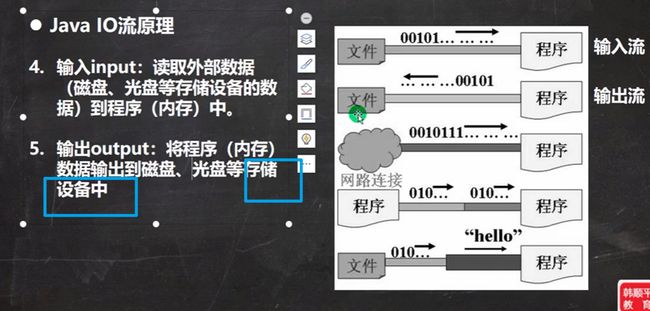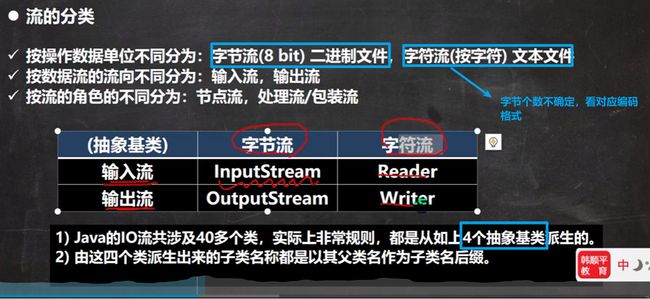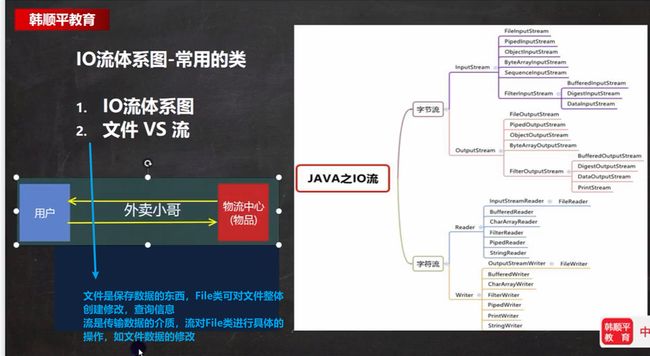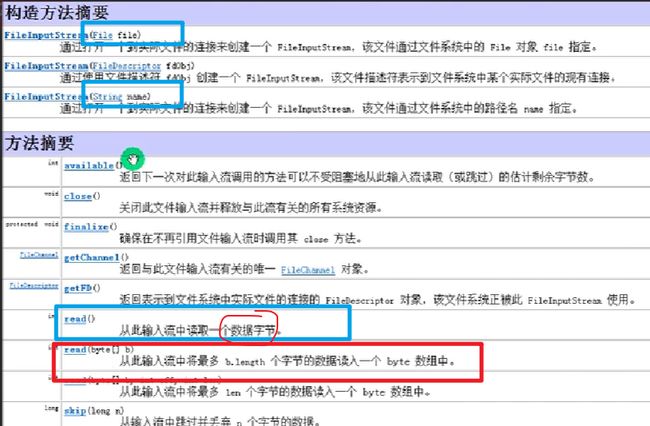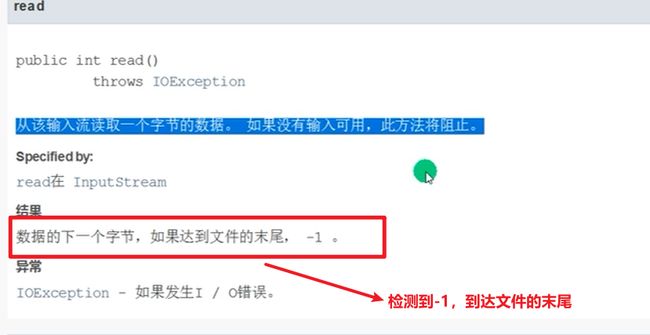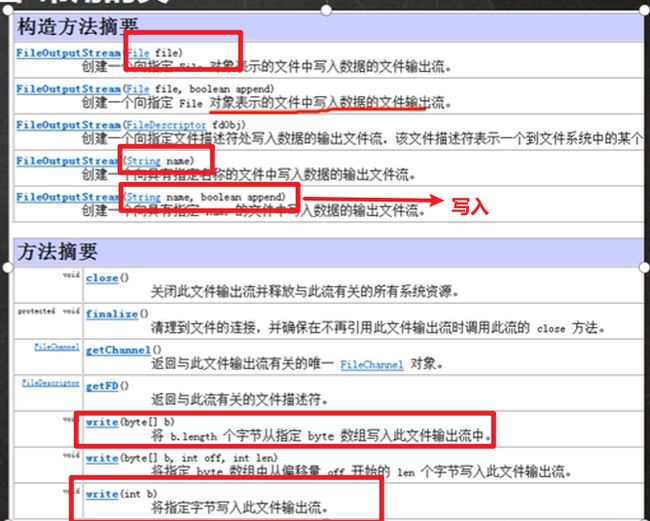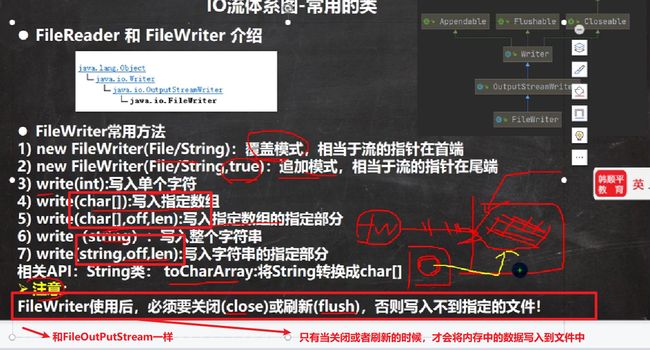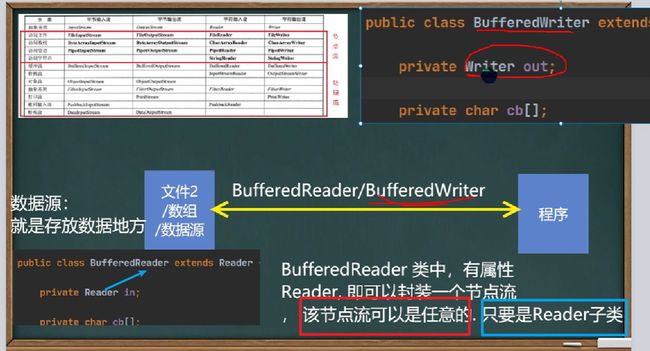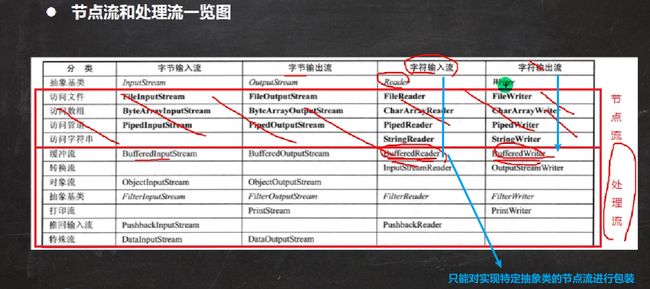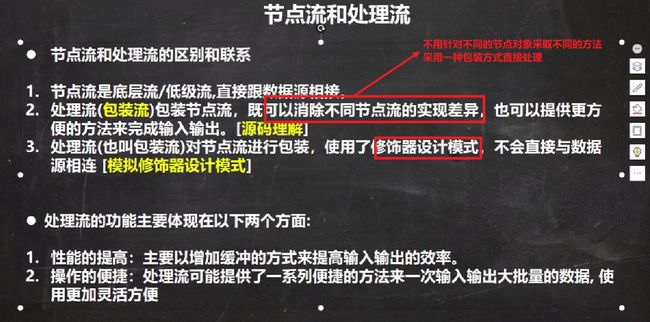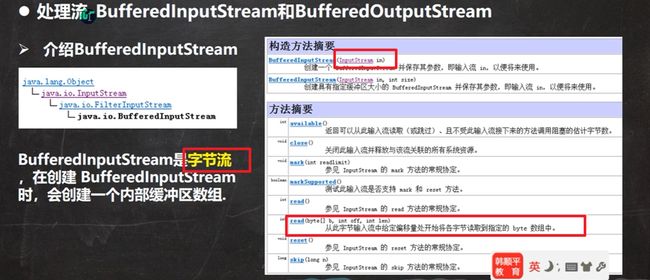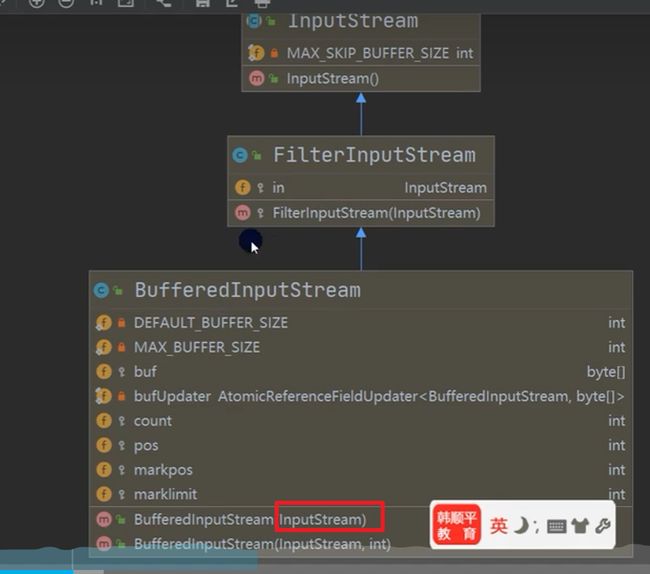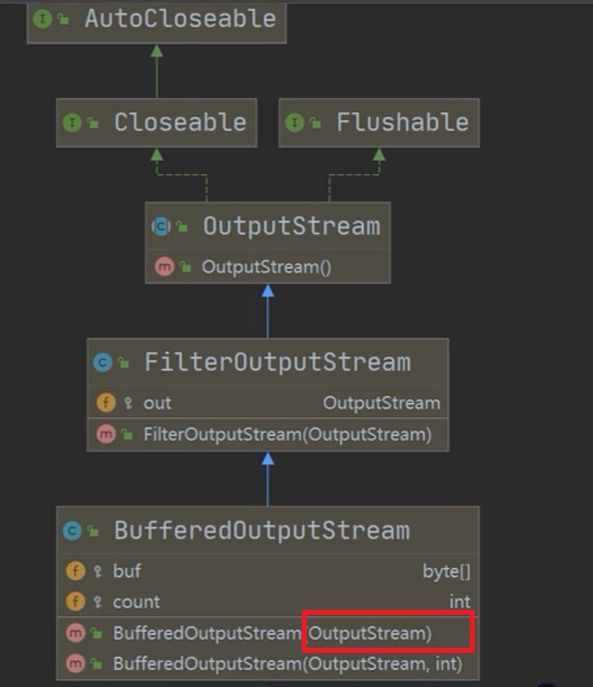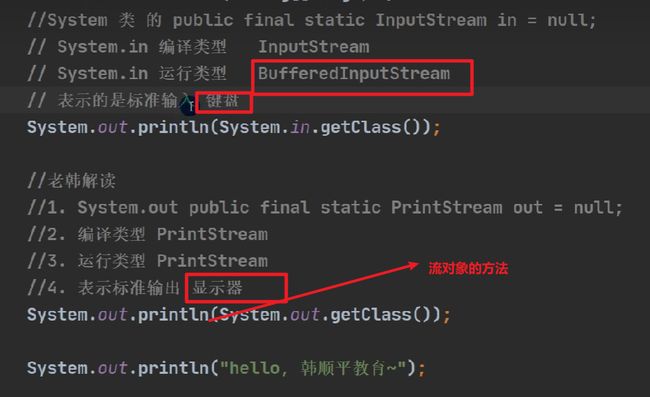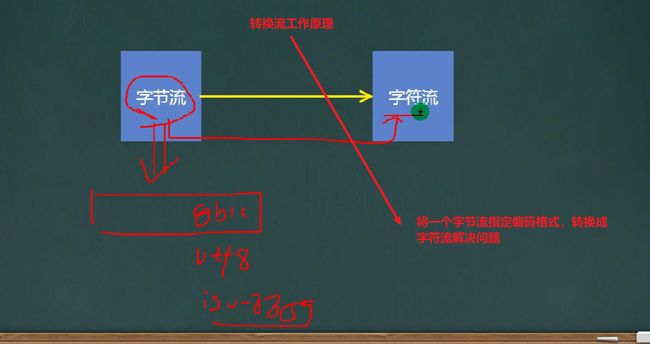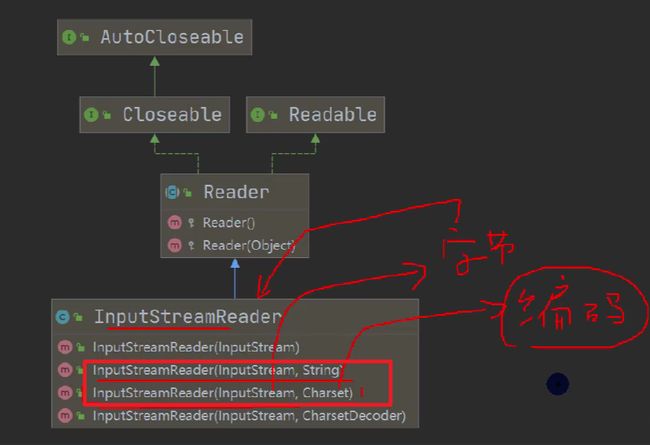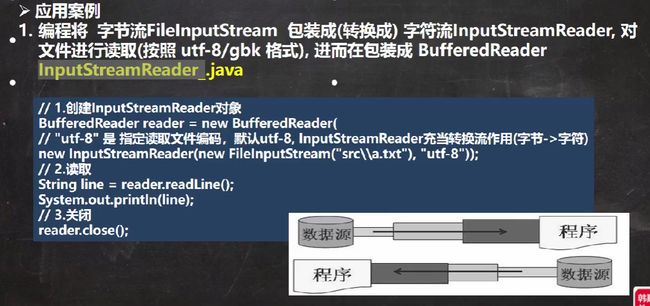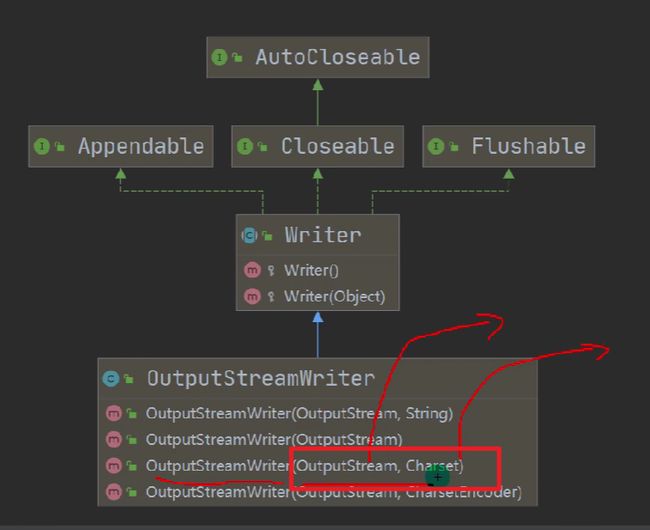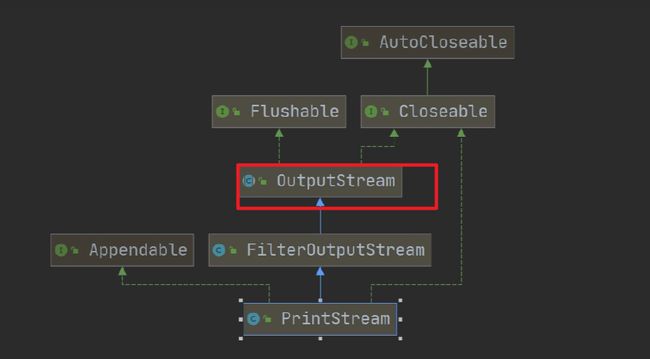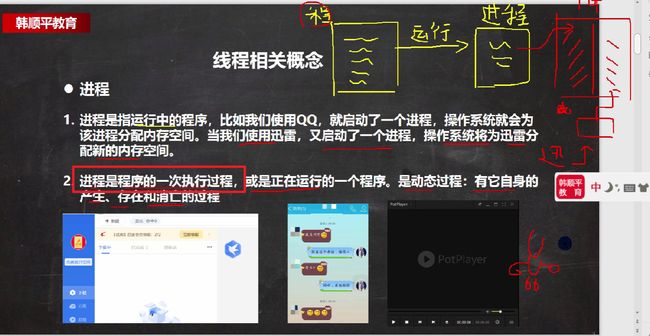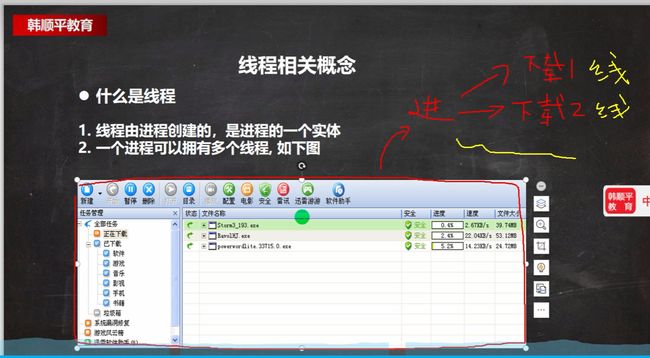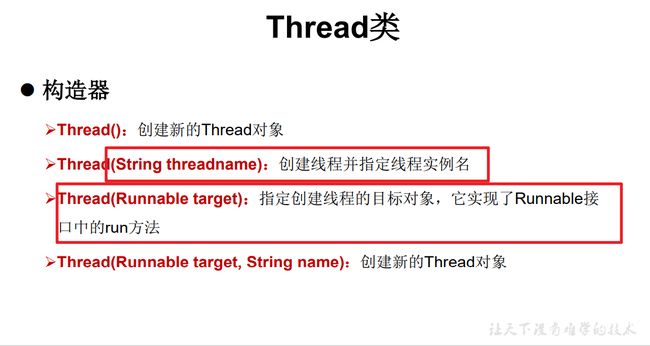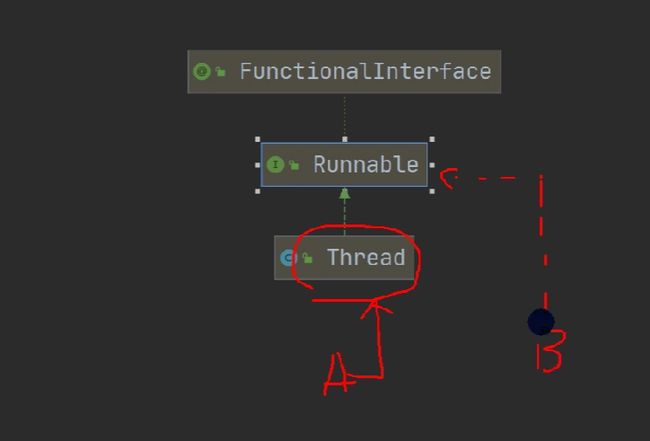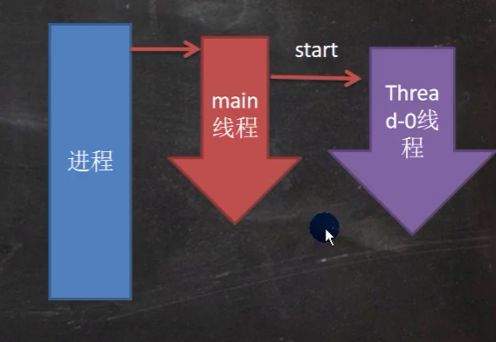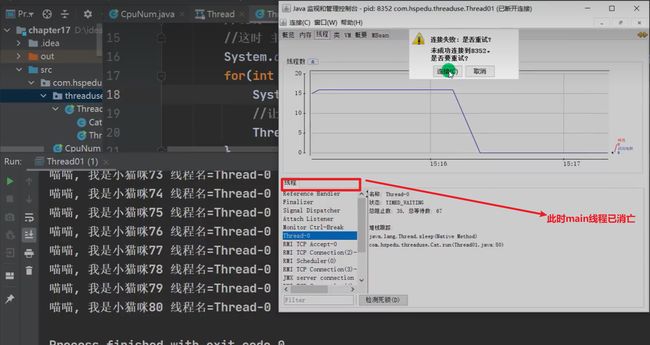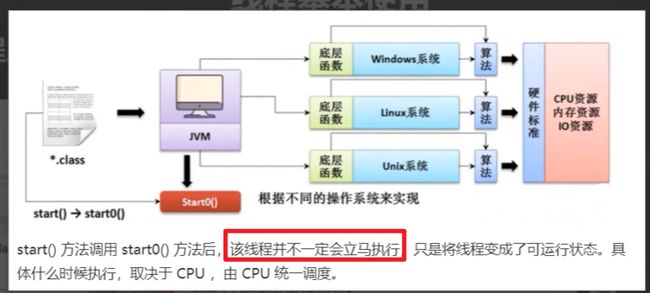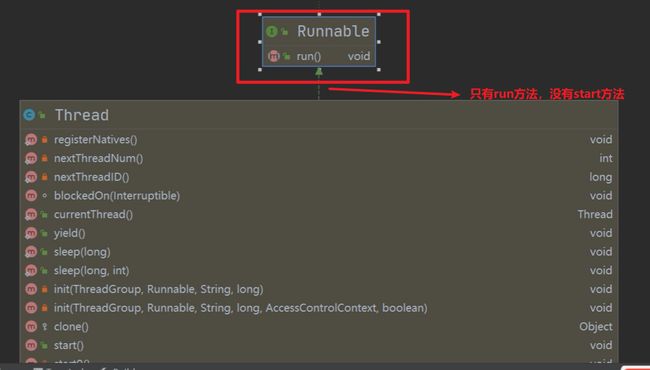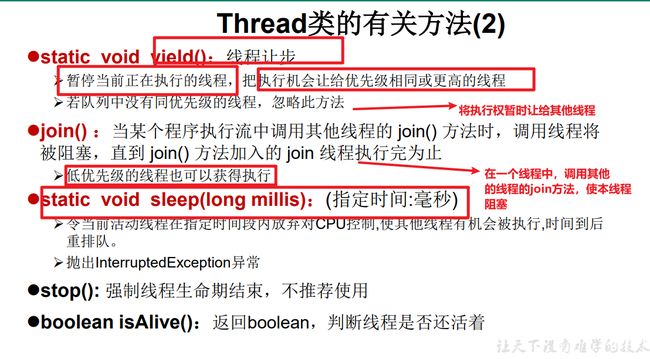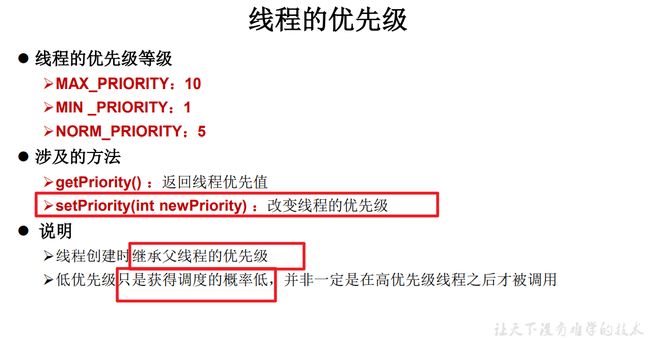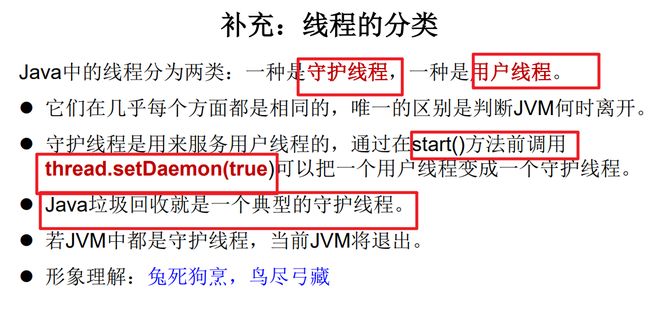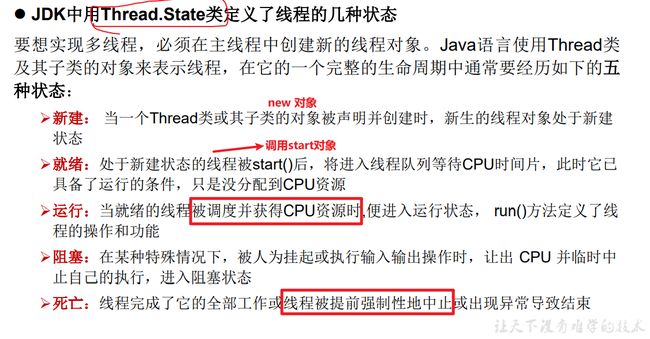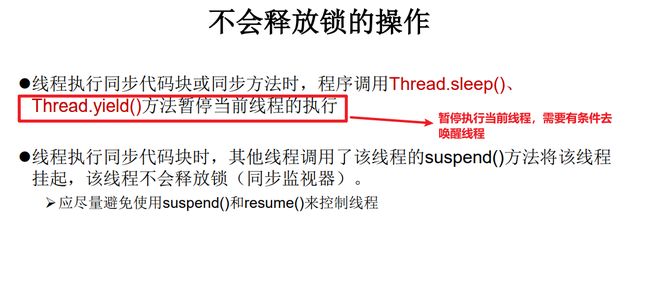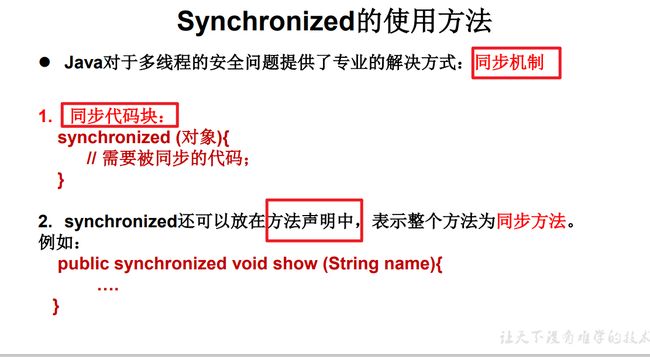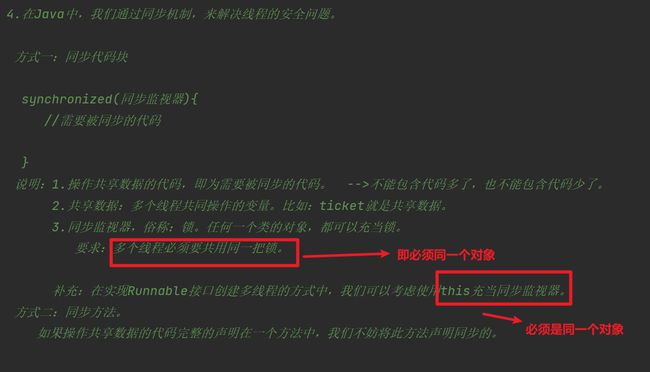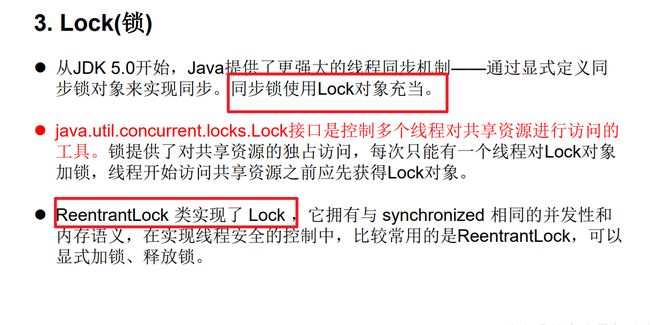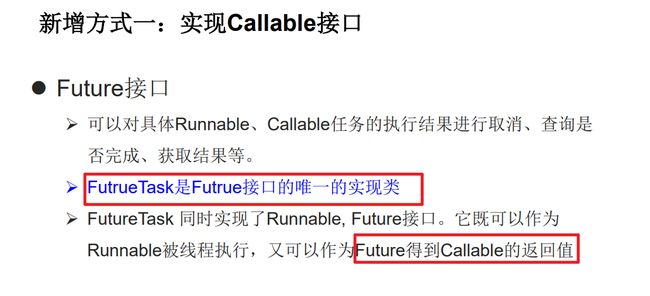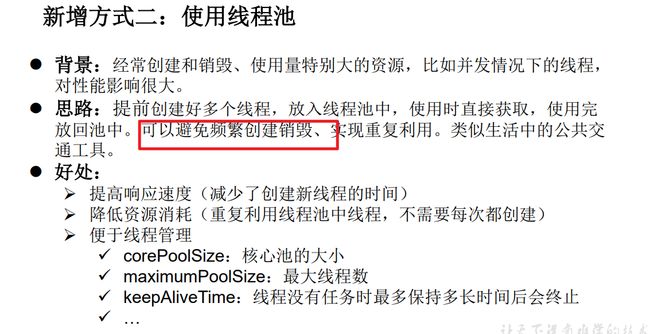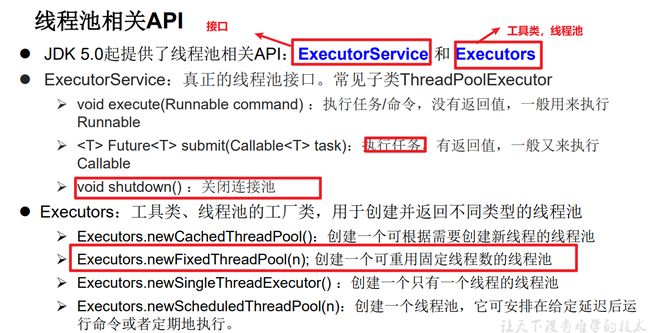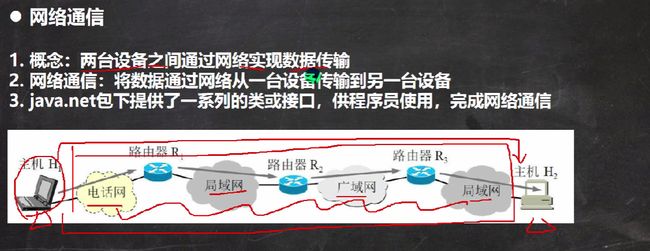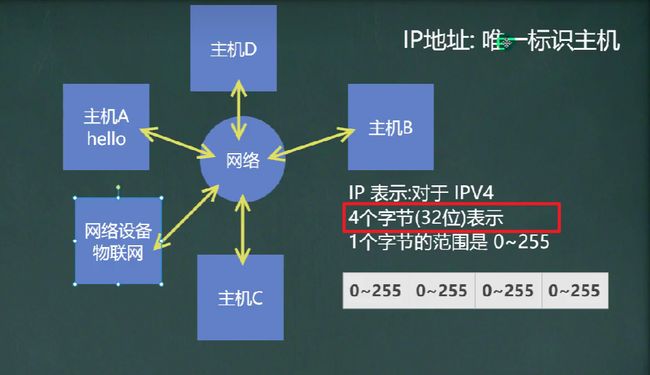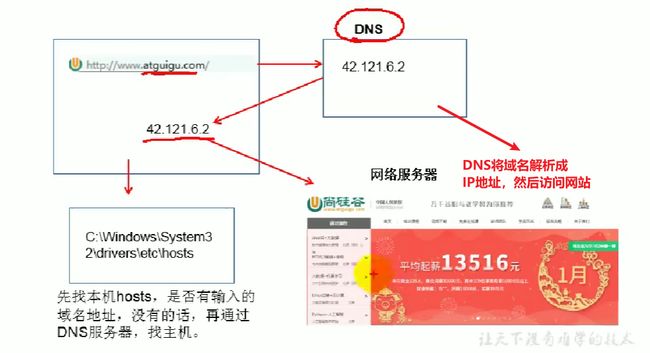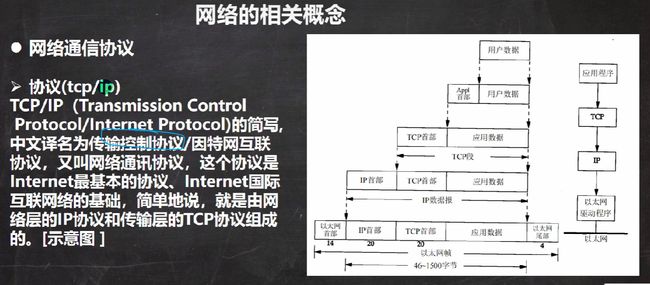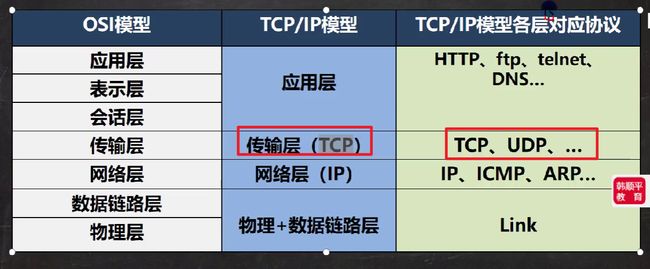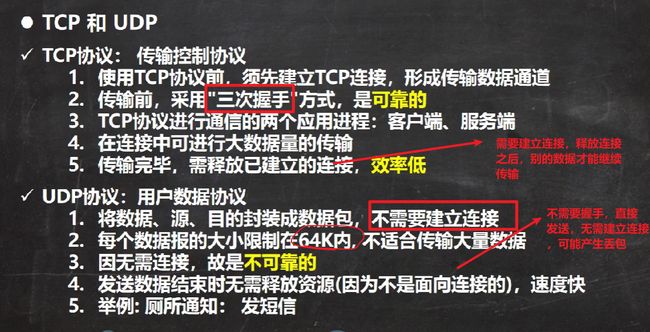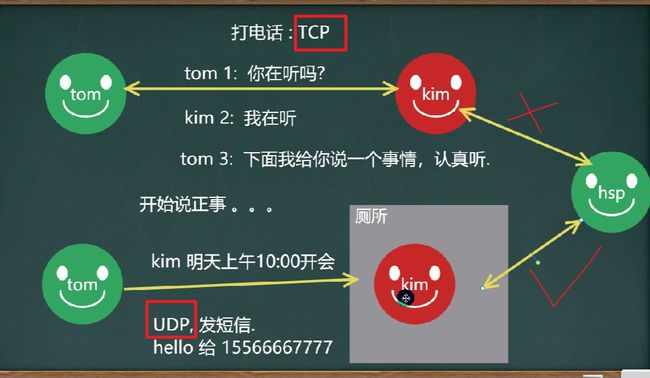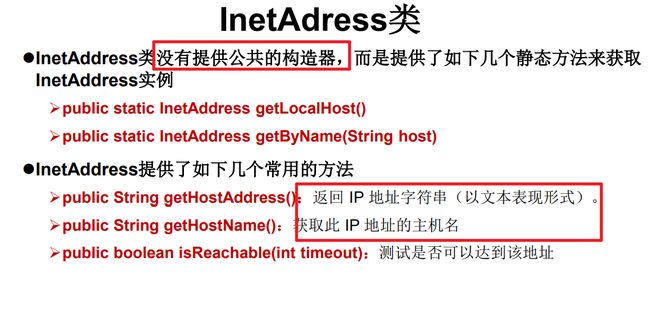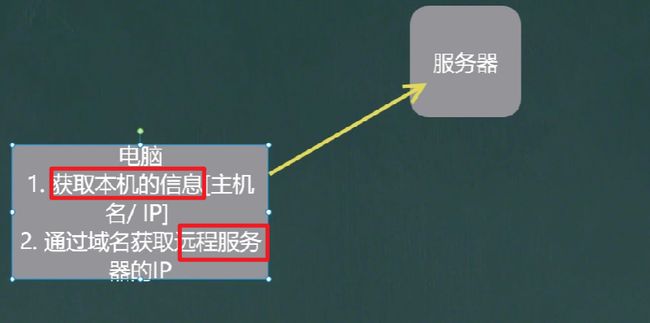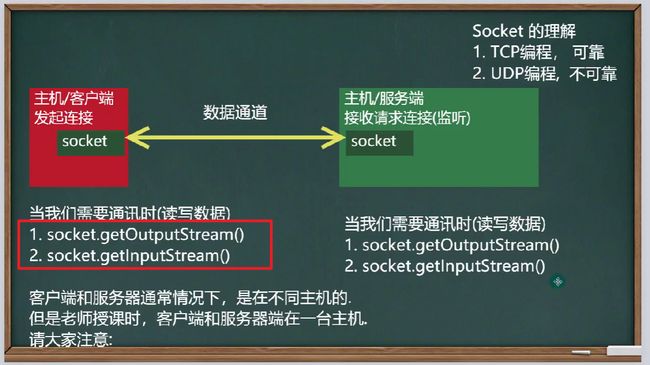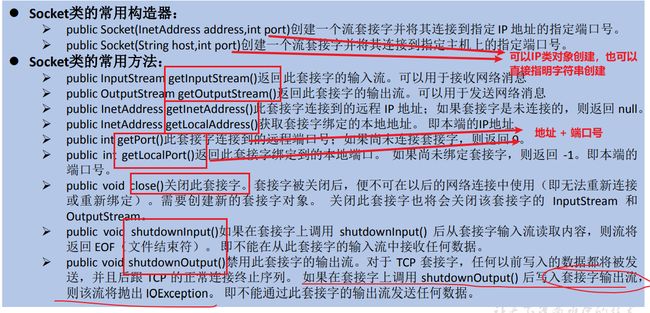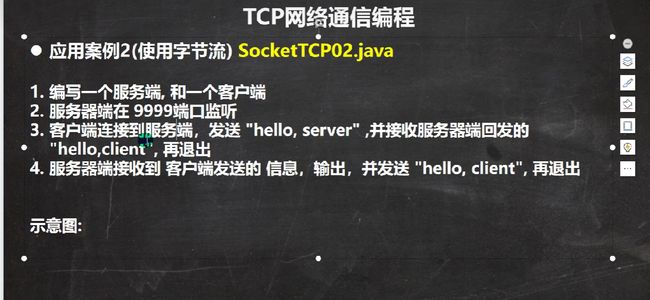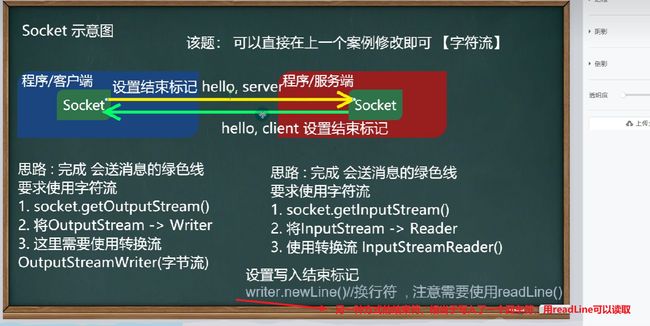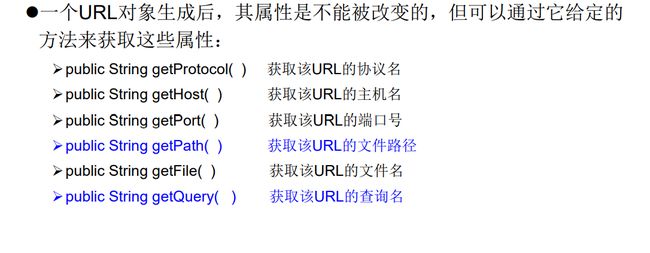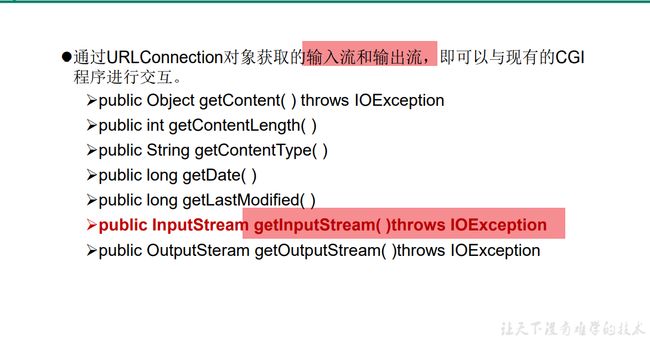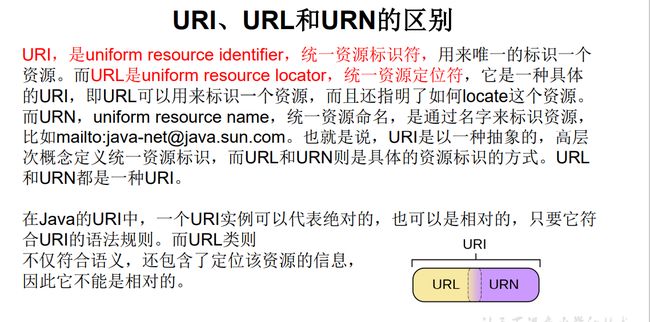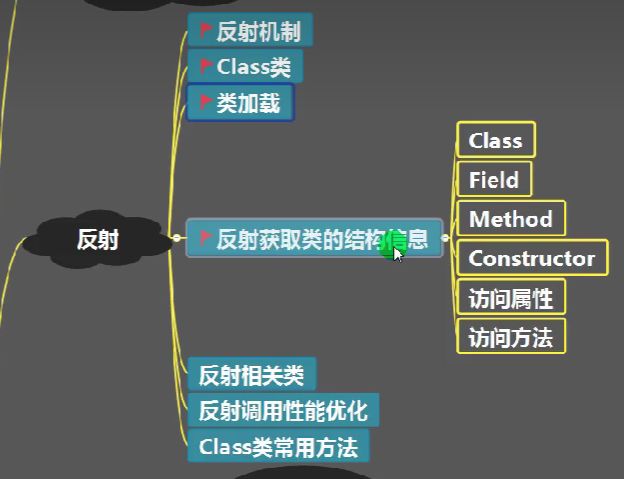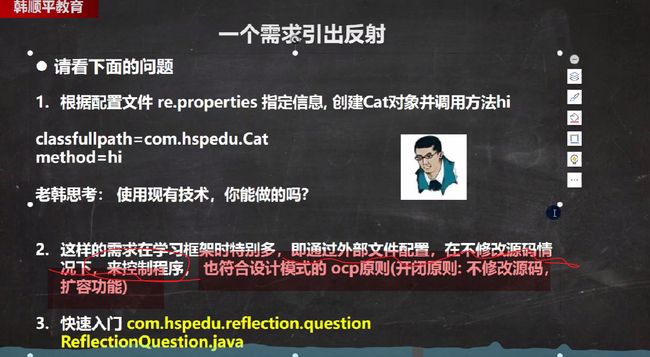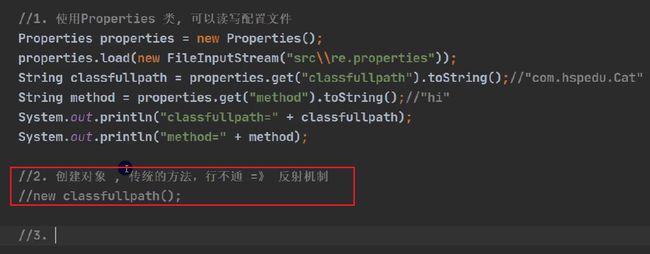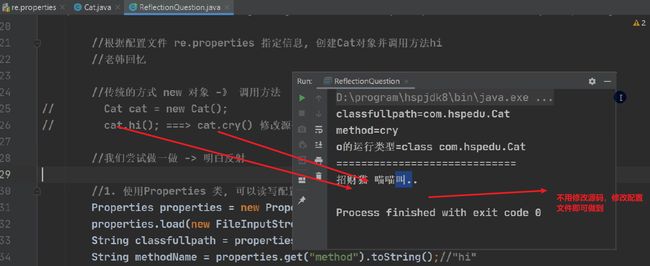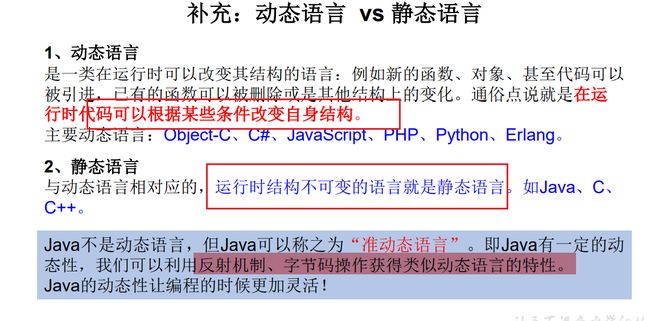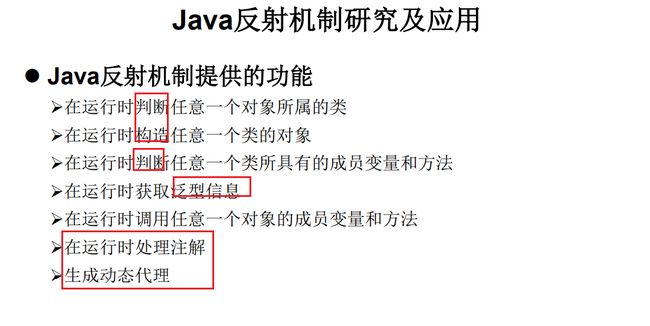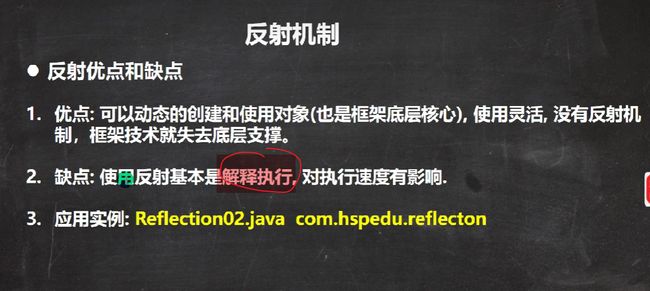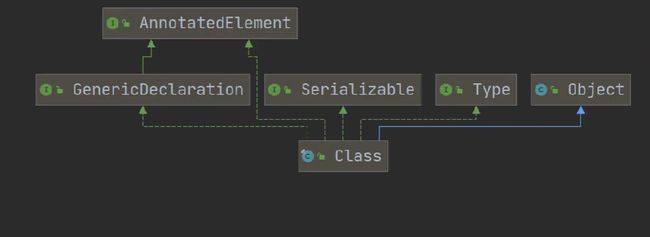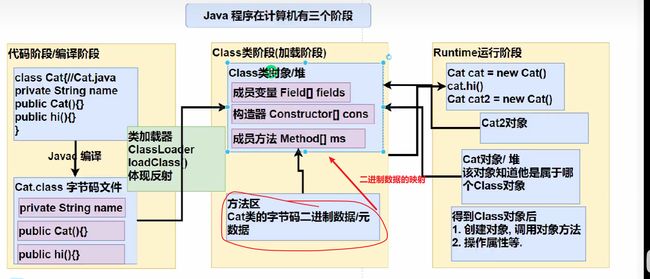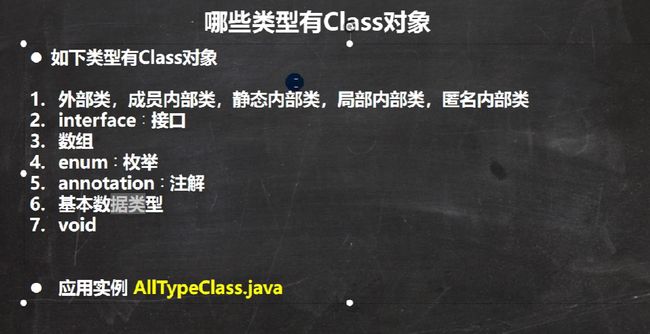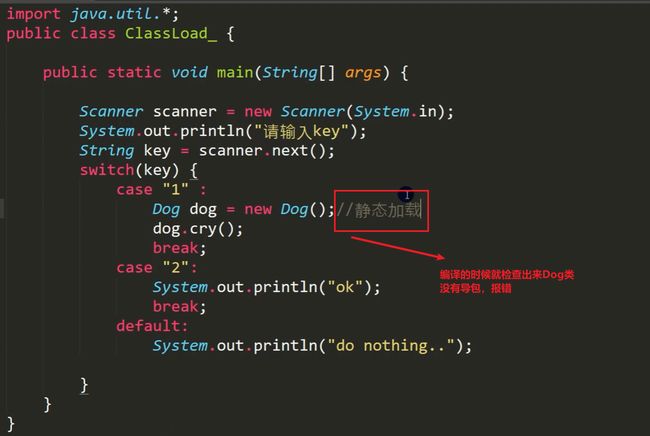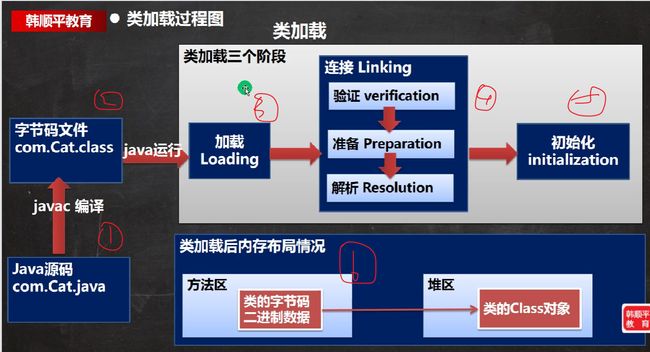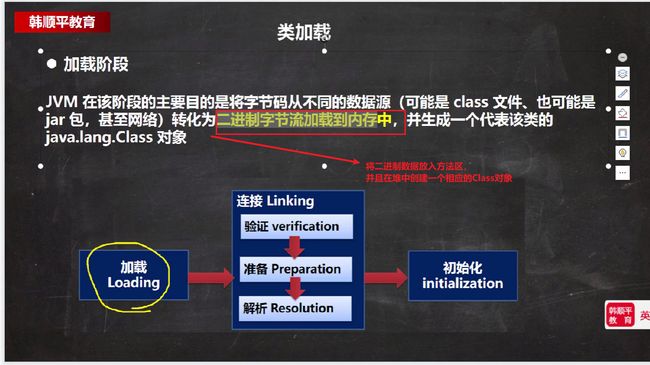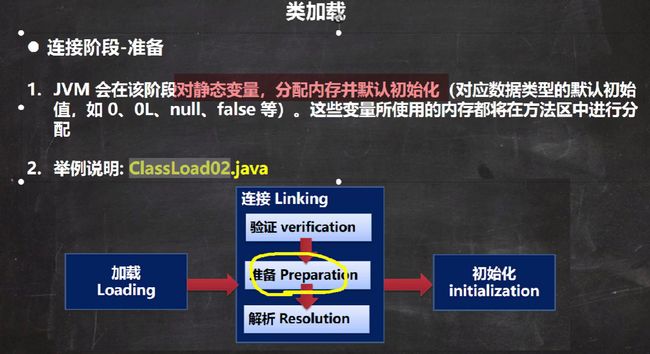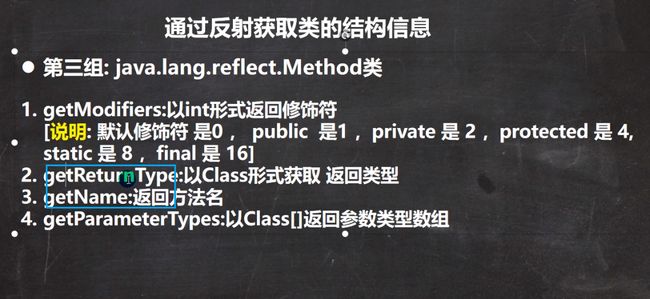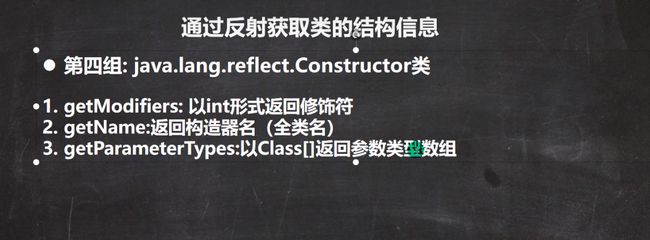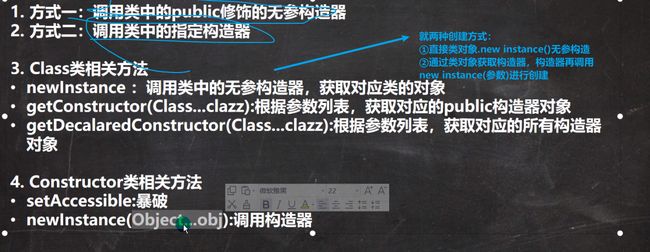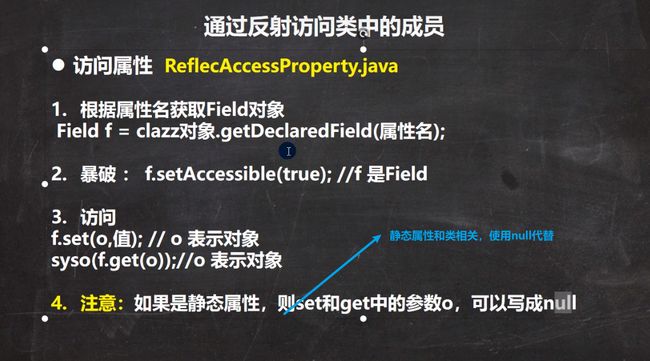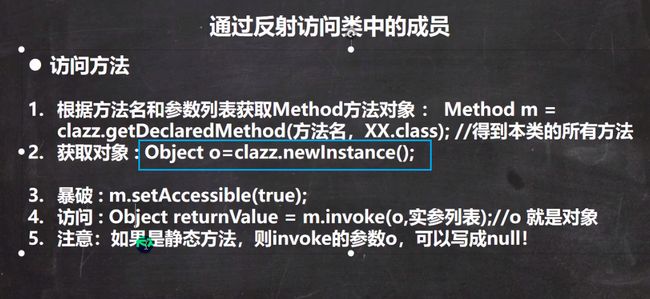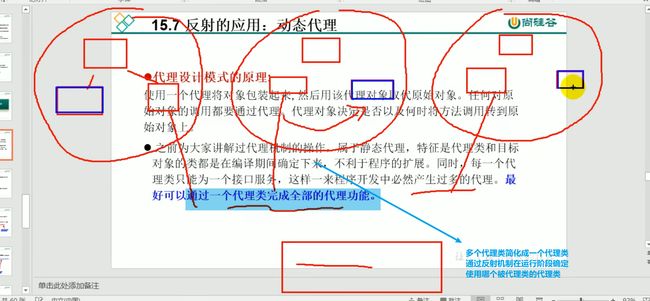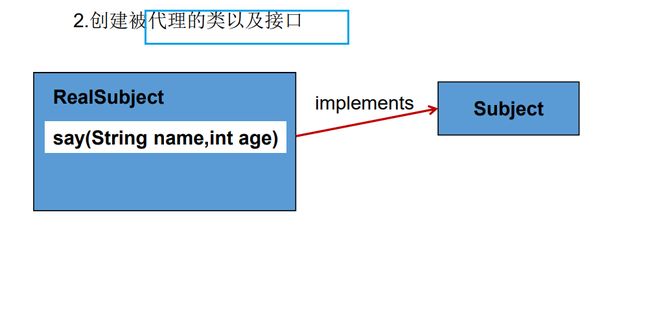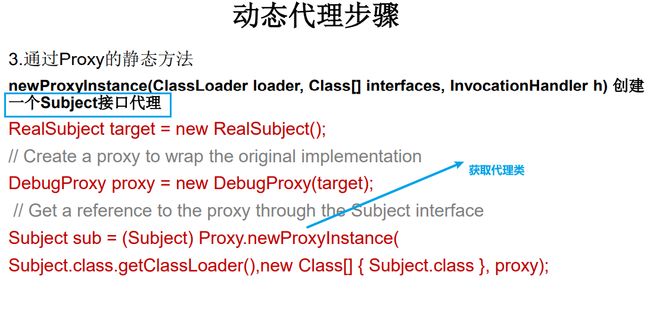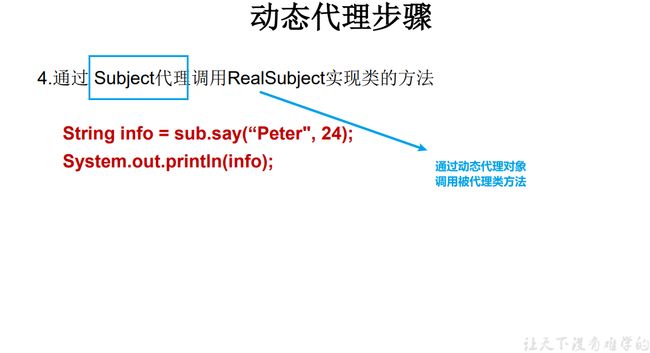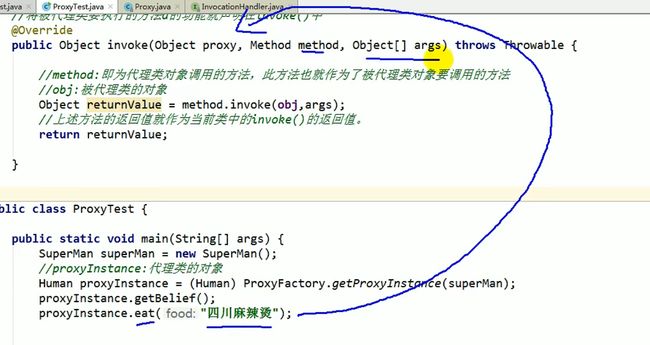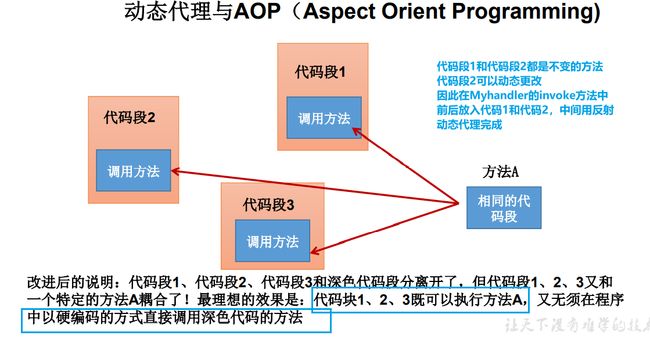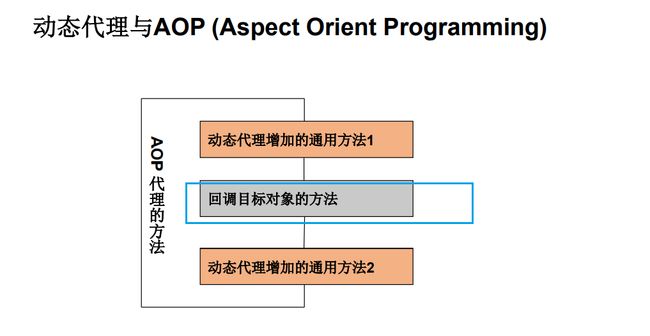JavaSE-part2
文章目录
- Day07 IO流
-
- 1.IO流
-
- 1.1背景介绍
- 1.2File类
-
- 1.2.1常用方法
- 1.3IO流原理
- 1.4IO流的分类
-
- 1.4.1InputStream 字节输入流
-
- 1.4.1.1FileInputStream
- 1.4.1.2FileOutPutStream
- 1.4.1.3练习
- 1.4.2Reader and Writer
-
- 1.4.2.1FileReader
- 1.4.2.2FileWriter
- 1.4.3节点流和处理流
-
- 1.4.3.1处理流的优点
- 1.4.3.2装饰者模式
- 1.4.4Buffered
-
- 1.4.4.1BufferedReader
- 1.4.4.2BufferedWriter
- 1.4.4.3BufferedInputStream
- 1.4.4.4BufferedOutputStream
- 1.4.5Object
-
- 1.4.5.1ObjectInputStream
- 1.4.5.2ObjectOutputStream
- 1.4.6标准输入输出流(IO流的实例,不属于IO特定的分类)
- 1.4.7转换流(适用于处理纯文本文件)
-
- 1.4.7.1InputStreamReader(解码)
- 1.4.7.2OutputStreamWriter(编码)
- 1.4.8打印流
-
- 1.4.8.1PrintStream
- 1.4.8.2PrintWriter
- 1.4.9Properties
- 1.4.10练习
- 1.4.11总结
- Day08 多线程
-
- 1.多线程
-
- 1.1概念
- 1.2线程的使用
-
-
- 1.2.1多线程机制
- 1.2.2start方法
- 1.2.3实现Runnable接口
- 1.2.4线程方法
-
- 1.3线程生命周期
- 1.4线程的同步:star::star::star:
-
-
- 1.4.1解决方法(Synchronized代码块和方法)
- 1.4.2死锁问题
- 1.4.3Lock锁(线程安全)
-
- 1.5线程通信
- 1.6新增线程创建方法(jdk5.0~)
- Day09 网络编程
-
- 1.网络编程
-
- 1.1基础概念
-
- 1.1.2ip地址
- 1.1.3域名和端口号
- 1.1.4网络协议
- 1.1.5TCP和UDP:star::star::star:
- 1.2InetAddress类
- 1.3Socket
- 1.4TCP编程:star::star::star:
-
- 1.4.1字节流
- 1.4.2字符流
- 1.5UDP网络编程
- 1.6URL编程
- Day10 反射
-
- 1.反射
-
- 1.1反射概念和机制
-
- 1.1.1举例
- 1.1.2理解
-
- 1.1.2.1反射原理图:star::star::star:
- 1.1.2.2反射功能
- 1.2反射相关类
- 1.3反射的优点和缺点
- 1.4class类
-
- 1.4.1class类方法
- 1.4.2获取class类对象的六种方式
- 1.5类加载
-
- 1.5.1类加载时机:star::star::star:
- 1.5.2类加载各个阶段
-
- 1.5.2.1加载阶段
- 1.5.2.2连接
-
- 1.5.2.2.1验证阶段
- 1.5.2.2.2准备
- 1.5.2.2.3解析
- 1.5.2.3初始化
- 1.6通过反射获取类的结构信息
-
- 1.6.1第一组
- 1.6.2第二组(Field)
- 1.6.3第三组(Method)
- 1.6.4第四组(Constructor)
- 1.7运用反射机制进行操作
-
- 1.7.1通过反射创造对象
- 1.7.2通过反射操作属性
- 1.7.3通过反射调用方法
- 1.8动态代理:star::star::star:
-
- 1.8.1实现步骤:star:
-
- 1.8.1-1
- 1.8.2-2
- 1.8.3-3
- 1.8.4-4
- 1.8.5-5.main方法实现
- 1.8.2动态代理与AOP(面向切面编程)
Day07 IO流
1.IO流
1.1背景介绍
1.2File类
-
创建File类的对象,只是在内存中创建了一个对象,并没有写入到磁盘中,只有调用相应的CreateFile()方法,才能写入到磁盘中
-
文件这个类,按目录构建的时候是一个目录,按目录+文件名构建的时候是一个文件
-
java编程中目录也是一种文件
-
File类对象包括: 文件 + 目录
public class FileCreate {
public static void main(String[] args) {
}
@Test
//方式一:new File(String pathName)
public void method1(){
String path = "text1.txt";
File file = new File(path);//创建file对象,这时还没创建文件
try {
file.createNewFile();
System.out.println("文件创建成功");
} catch (IOException e) {
e.printStackTrace();
}
}
//方式 2 new File(File parent,String child) //根据父目录文件+子路径构建
@Test
public void method2(){
File file = new File("D:\\desktop\\666\\study\\Java\\javaseReverse");
String name = "text2.txt";
File file1 = new File(file, name);
try {
file1.createNewFile();
System.out.println("文件创建成功");
} catch (IOException e) {
e.printStackTrace();
}
}
//方式 3 new File(String parent,String child) //根据父目录+子路径构建
@Test
public void method3(){
String parentPath = "D:\\desktop\\666\\study\\";
String childPath = "Java\\javaseReverse\\text3.txt";
File file = new File(parentPath, childPath);
try {
file.createNewFile();
System.out.println("文件创建成功");
} catch (IOException e) {
e.printStackTrace();
}
}
}
1.2.1常用方法
//获取文件信息
@Test
public void test1(){
//加载文件对象
File file = new File("text1.txt");
System.out.println(file.getName());
//调用相应的方法,得到对应信息
System.out.println("文件名字=" + file.getName());
//getName、getAbsolutePath、getParent、length、exists、isFile、isDirectory
System.out.println("文件绝对路径=" + file.getAbsolutePath());
System.out.println("文件父级目录=" + file.getParent());//这个文件没有指定父目录,是按相对路径创建的,所以返回null
System.out.println("文件大小(字节)=" + file.length());
System.out.println("文件是否存在=" + file.exists());//T
System.out.println("是不是一个文件=" + file.isFile());//T
System.out.println("是不是一个目录=" + file.isDirectory());//F
}
//删除文件操作 file.delete()
@Test
public void method1(){
File file = new File("text3.txt");
if(file.exists()){
boolean delete = file.delete();
if(delete){
System.out.println("文件删除成功");//T
}else{
System.out.println("文件删除不成功");
}
}else{
System.out.println("文件不存在");
}
}
//删除目录操作 file.delete()
//目录也是一种特殊的文件
@Test
public void method2(){
File file = new File("e:\\demo");
if(file.exists()){
boolean delete = file.delete();
if(delete){
System.out.println("目录删除成功");
}else{
System.out.println("目录删除不成功");
}
}else{
System.out.println("目录不存在");//T
}
}
//判断目录是否存在,如果不存在创建该目录
//mkdirs()针对的是目录文件
@Test
public void method3(){
File file = new File("e:\\demo\\a\\b");
if(file.exists()){
System.out.println("该目录已存在");
}else{
if(file.mkdirs()){创建多级目录
System.out.println("该目录创建成功");//T
}else{
System.out.println("创建失败");
}
}
}
1.3IO流原理
1.4IO流的分类
- 一般用循环读取文件(读取文件注意返回值),然后写入(直接写入就完事了)
1.4.1InputStream 字节输入流
- read:要么一个一个读取,要不创建一个byte数组,多次读取
1.4.1.1FileInputStream
/**
* 演示读取文件... * 单个字节的读取,效率比较低
* -> 使用 read(byte[] b)
*/
@Test
public void readFile01(){
String filePath = "text1.txt";
FileInputStream fis = null;
try {
fis = new FileInputStream(filePath);
int readContext;
//从该输入流读取一个字节的数据。 如果没有输入可用,此方法将阻止。
//如果返回-1 , 表示读取完毕
while((readContext = fis.read()) != -1){
System.out.println((char) readContext);//中文会乱码
}
} catch (IOException e) {
e.printStackTrace();
} finally {
try {
fis.close();
} catch (IOException e) {
e.printStackTrace();
}
}
}
- 每次对流进行操作完,关闭流 的根本原因是,文件描述符不属于jvm管理的,是没有办法通过垃圾回收器回收,因此必须手动关闭
![]()
/**
*
* -> 使用 read(byte[] b),一次读取好几个,效率较高
*/
@Test
public void readFile02() {
String filePath = "text1.txt";
FileInputStream fis = null;
try {
fis = new FileInputStream(filePath);
byte[] buff = new byte[5];
int readLen;
//从该输入流读取最多 b.length 字节的数据到字节数组。 此方法将阻塞,直到某些输入可用。
//如果返回-1 , 表示读取完毕
//如果读取正常, 返回实际读取的字节数
//如果读取的不够5个字节,那么就返回实际读取的字节数
while ((readLen = fis.read(buff)) != -1) {
System.out.println(new String(buff,0,readLen));//用String来讲字节数组转换为字符,这里不能直接用byte[]数组
//因为最后如果读取小于五个字符,输出的buff数组前一部分为读取的
//部分,其他部分为之前的部分,因此每次buff数组只取实际读取的
//一部分
}
} catch (IOException e) {
e.printStackTrace();
} finally {
try {
fis.close();
} catch (IOException e) {
e.printStackTrace();
}
}
}
1.4.1.2FileOutPutStream
- 特殊的一点是:如果文件不存在,那么会新建一个文件
- 构造器,后面加True是追加的形式
- 写入的时候:是以字节的形式进行写入的,因此要调用String.getbytes()方法转换为字节数组再写入
![]()
@Test
public void writeFile() {
//创建 FileOutputStream 对象
String filePath = "text3.txt";
FileOutputStream fileOutputStream = null;
try {
//得到 FileOutputStream 对象 对象
//老师说明
//1. new FileOutputStream(filePath) 创建方式,当写入内容是,会覆盖原来的内容
//2. new FileOutputStream(filePath, true) 创建方式,当写入内容是,是追加到文件后面
fileOutputStream = new FileOutputStream(filePath, true);
//写入一个字节
//fileOutputStream.write('H');//
//写入字符串
String str = "hsp,world!";
//str.getBytes() 可以把 字符串-> 字节数组
//fileOutputStream.write(str.getBytes());
/*
write(byte[] b, int off, int len) 将 len 字节从位于偏移量 off 的指定字节数组写入此文件输出流
*/
fileOutputStream.write(str.getBytes(), 0, 3);
} catch (IOException e) {
e.printStackTrace();
} finally {
try {
fileOutputStream.close();
} catch (IOException e) {
e.printStackTrace();
}
}
}
1.4.1.3练习
@Test
public void testCopy(){
String filePath = "java.jpg";
FileInputStream fis = null;
FileOutputStream fos = null;
try {
//读取文件
fis = new FileInputStream(filePath);
fos = new FileOutputStream("javaCopy.jpg");
//读取到后,就写入到文件 通过 fileOutputStream
//即,是一边读,一边写
byte[] buff = new byte[1024];
int readLen;
while((readLen = fis.read(buff)) != -1){
fos.write(buff,0,readLen);
}
} catch (FileNotFoundException e) {
e.printStackTrace();
} catch (IOException e) {
e.printStackTrace();
} finally {
try {
fis.close();
} catch (IOException e) {
e.printStackTrace();
}
try {
fos.close();
} catch (IOException e) {
e.printStackTrace();
}
}
}
1.4.2Reader and Writer
1.4.2.1FileReader
@Test
public void storyReader(){
String filePath = "story.txt";
FileReader fr = null;
try {
fr = new FileReader(filePath);
char[] readContext = new char[1024];
int readCount;
while((readCount = fr.read(readContext)) != -1){
System.out.print(new String(readContext,0,readCount));这里一定要用String处理
}
} catch (FileNotFoundException e) {
e.printStackTrace();
} catch (IOException e) {
e.printStackTrace();
}finally {
if(fr != null){
try {
fr.close();
} catch (IOException e) {
e.printStackTrace();
}
}
}
}
1.4.2.2FileWriter
- 在write方法写入完数据之后,一定要flush或者close流,这样才能把数据真正地写入到文件中
public class FileWriter_ {
public static void main(String[] args) {
}
@Test
public void test(){
String filePath = "note.txt";
//创建 FileWriter 对象
FileWriter fileWriter = null;
char[] chars = {'a', 'b', 'c'};
try {
fileWriter = new FileWriter(filePath);//默认是覆盖写入
// 3) write(int):写入单个字符
fileWriter.write('H');
// 4) write(char[]):写入指定数组
fileWriter.write(chars);
// 5) write(char[],off,len):写入指定数组的指定部分
fileWriter.write("韩顺平教育".toCharArray(), 0, 3);
// 6) write(string):写入整个字符串
fileWriter.write(" 你好北京~");
fileWriter.write("风雨之后,定见彩虹");
// 7) write(string,off,len):写入字符串的指定部分
fileWriter.write("上海天津", 0, 2);
}catch (IOException e){
e.printStackTrace();
} finally {
//对应 FileWriter , 一定要关闭流,或者 flush 才能真正的把数据写入到文件
//老韩看源码就知道原因. /*
// 看看代码
// private void writeBytes() throws IOException {
// this.bb.flip();
// int var1 = this.bb.limit();
// int var2 = this.bb.position();
// assert var2 <= var1;
// int var3 = var2 <= var1 ? var1 - var2 : 0;
// if (var3 > 0) {
// if (this.ch != null) {
// assert this.ch.write(this.bb) == var3 : var3;
// } else {
// this.out.write(this.bb.array(), this.bb.arrayOffset() + var2, var3);
//
// }
// }
// }
// this.bb.clear();
// }
try {
//fileWriter.flush();
//关闭文件流,等价 flush() + 关闭
fileWriter.close();
} catch (IOException e) {
e.printStackTrace();
}
}
}
}
1.4.3节点流和处理流
- 之前学过的处理文件的流都是节点流
- 处理流可以套一层节点流,使处理功能更强大
- 区分关键点:如果直接对对象(数据)进行处理,是节点流;有功能名字的流都是处理流
![]()
![]()
1.4.3.1处理流的优点
1.4.3.2装饰者模式
![]()
1.4.4Buffered
1.4.4.1BufferedReader
- 主要方法是跟以前一样还是有read()方法,新增方法readline读取一行,效率更高,读取到文件末尾返回null
public class BufferedReader_ {
public static void main(String[] args) throws Exception{
String filePath = "story.txt";
BufferedReader reader = new BufferedReader(new FileReader(filePath));
//说明
//1. bufferedReader.readLine() 是按行读取文件
//2. 当返回 null 时,表示文件读取完毕
String line = null;
while((line = reader.readLine()) != null){
System.out.println(line);
}
//只需关闭外部流即可
reader.close();
}
}
1.4.4.2BufferedWriter
- 和以前一样有writer方法,可以按照char[]数组写入,也可以按照String数组写入
public class BufferedWriter_ {
public static void main(String[] args) throws Exception{
String filePath = "text2.txt";
//创建 BufferedWriter
//说明:
//1. new FileWriter(filePath, true) 表示以追加的方式写入
//2. new FileWriter(filePath) , 表示以覆盖的方式写入
BufferedWriter bufferedWriter = new BufferedWriter(new FileWriter(filePath));
bufferedWriter.write("hello, 韩顺平教育!");
bufferedWriter.newLine();//插入一个和系统相关的换行
bufferedWriter.write("hello2, 韩顺平教育!");
bufferedWriter.newLine();
bufferedWriter.write("hello3, 韩顺平教育!");
bufferedWriter.newLine();
//说明:关闭外层流即可 , 传入的 new FileWriter(filePath) ,会在底层关闭
bufferedWriter.close();
}
}
public class BufferedCopy {
public static void main(String[] args) throws Exception{
//1. BufferedReader 和 BufferedWriter 是安装字符操作
//2. 不要去操作 二进制文件[声音,视频,doc, pdf ], 可能造成文件损坏
String srcFilePath = "story.txt";
String destFilePath = "storyCopy.txt";
BufferedReader reader = new BufferedReader(new FileReader(srcFilePath));
BufferedWriter writer = new BufferedWriter(new FileWriter(destFilePath));
String readContext = null;
//readline读取一行的内容,但是不读取换行符
while ( (readContext = reader.readLine()) != null){
writer.write(readContext);
//插入一个换行符,与系统文件相关
writer.newLine();
}
reader.close();
writer.close();
}
}
1.4.4.3BufferedInputStream
1.4.4.4BufferedOutputStream
1.4.5Object
1.4.5.1ObjectInputStream
-
反序列化的时候一定要按照序列化的顺序来,否则会报异常
-
序列化的类和反序列化解析出来的类是同一个类,否则会报异常,因为只有这样解析出来的才能使一个类
-
实际意义是,都是存放一个类对象的文件,便于读取
-
序列化对象时,建议添加serialVersionUID,提高版本兼容性
-
序列化对象默认将里面的对象都序列化,除了static和transient,transient就代表不想序列化
-
序列化类属性必须实现可序列化接口,才能序列化类
public class Dog implements Serializable {
private String name;
private int age;
private String country;
private String color;
//序列化版本号,提高版本兼容性
private static final long serialVersionUID = 1L;
public Dog(String name, int age, String country, String color) {
this.name = name;
this.age = age;
this.country = country;
this.color = color;
}
@Override
public String toString() {
return "Dog{" +
"name='" + name + '\'' +
", age=" + age +
", country='" + country + '\'' +
", color='" + color + '\'' +
'}';
}
public String getName() {
return name;
}
public void setName(String name) {
this.name = name;
}
public int getAge() {
return age;
}
public void setAge(int age) {
this.age = age;
}
public String getCountry() {
return country;
}
public void setCountry(String country) {
this.country = country;
}
public String getColor() {
return color;
}
public void setColor(String color) {
this.color = color;
}
}
public class ObjectInputStream_ {
public static void main(String[] args) throws Exception{
String filePath = "data.txt";
ObjectInputStream ois = new ObjectInputStream(new FileInputStream(filePath));
//反序列化的时候一定要按照序列化的顺序来
//否则会报异常
System.out.println(ois.readInt());
System.out.println(ois.readBoolean());
System.out.println(ois.readChar());
System.out.println(ois.readDouble());
System.out.println(ois.readUTF());
//这里有一个重要的细节
//1.如果我们希望调用Dog的方法,需要向下转型
//2.需要我们将Dog类的定义,方法到可以引用的位置,这样序列化和反序列化出来的类的和引用的位置一致
//换句话说,就是序列化的类和反序列化解析出来的类是同一个类
Object obj = ois.readObject();
Dog dog = (Dog)obj;
System.out.println(dog);
System.out.println(dog.getName());
ois.close();
}
}
1.4.5.2ObjectOutputStream
- 序列化后的保存的文本的格式不是纯文本的,是一种
![]()
public class ObjectOutputStream_ {
public static void main(String[] args) throws Exception{
//序列化后,保存的文件格式,不是存文本,而是按照他的格式来保存
String filePath = "data.txt";
ObjectOutputStream oos = new ObjectOutputStream(new FileOutputStream(filePath));
//序列化数据到 e:\data.dat
oos.writeInt(100);// int -> Integer (实现了 Serializable)
oos.writeBoolean(true);// boolean -> Boolean (实现了 Serializable)
oos.writeChar('a');// char -> Character (实现了 Serializable)
oos.writeDouble(9.5);// double -> Double (实现了 Serializable)
oos.writeUTF("韩顺平教育");//String
//保存一个 dog 对象
oos.writeObject(new Dog("旺财", 10, "日本", "白色"));
oos.close();
System.out.println("数据保存完毕(序列化形式)");
}
}
//如果没有实现Serializable,就会报java.io.NotSerializableException异常
//class Dog implements Serializable {
// private String name;
// private int age;
// private String country;
// private String color;
//
// public Dog(String name, int age, String country, String color) {
// this.name = name;
// this.age = age;
// this.country = country;
// this.color = color;
// }
//}
1.4.6标准输入输出流(IO流的实例,不属于IO特定的分类)
1.4.7转换流(适用于处理纯文本文件)
- 解决编码问题
1.4.7.1InputStreamReader(解码)
-
本质上就是将字节流转换为字符流,因为InputStreamReader是Reader的子类,得到一个转换过的字符流(reader)罢了
可以在转换后用BufferedReader进行包装,因为BufferedReader可接收Reader及其子类的对象,处理效率更高
public class InputStreamReader_ {
public static void main(String[] args) throws Exception{
String filePath = "text2.txt";
//解读
// 1. 把 FileInputStream 转成 InputStreamRea
//2. 指定解码格式 utf-8
InputStreamReader isr = new InputStreamReader(new FileInputStream(filePath), "utf-8");
BufferedReader bufferedReader = new BufferedReader(isr);
String str = null;
while((str = bufferedReader.readLine()) != null){
System.out.println(str);
}
//只用关闭最外层流,即BufferedReader即可
bufferedReader.close();
}
}
1.4.7.2OutputStreamWriter(编码)
public class OutputStreamWriter_ {
public static void main(String[] args) throws Exception{
String filePath = "编码格式gbk.txt";
FileOutputStream fos = new FileOutputStream(filePath);
OutputStreamWriter osw = new OutputStreamWriter(fos, "gbk");
BufferedWriter bufferedWriter = new BufferedWriter(osw);
bufferedWriter.write("你好,世界");
bufferedWriter.close();
}
}
1.4.8打印流
1.4.8.1PrintStream
-
就两个关键点,一个是构造器(指定传入位置的功能),一个是输出方法
-
printStream构造器方法可以直接传入一个文件路径(String或者File),这样可以修改输出的位置
-
这个类的print方法和write方法异曲同工,都是输出信息到指定位置
-
System.SetOut方法可以直接传入一个指定位置的输出流printStream,进行位置的修改
-
System.out的输出流输出到控制台上的,因此要指定输出内容到控制台,可传入System.out
public class PrintStream_ {
public static void main(String[] args) throws Exception{
//1.
PrintStream ps = System.out;
//在默认情况下PrintStream输出的位置是标准输出,即显示器
ps.print("hello world");
// public void print(String s) {
// write(String.valueOf(s));
// }
//因为print底层使用Write方法,所以我们可以直接使用Write进行打印/输出
ps.write("你好世界".getBytes(StandardCharsets.UTF_8));
//2.修改打印流的输出位置(设备)
System.setOut(new PrintStream("print.txt"));
System.out.print("你好世界");
ps.close();
}
}
1.4.8.2PrintWriter
public class PrintWriter_ {
public static void main(String[] args) throws Exception{
//输出方式1
// PrintWriter printWriter = new PrintWriter(System.out);//输出到控制台
//输出方式二
PrintWriter printWriter = new PrintWriter(new FileWriter("printWriter.txt"));//输出到文件中
printWriter.write("你好,世界");
printWriter.close();//一定要关闭,否则不写入数据
}
}
1.4.9Properties
1.4.10练习
public class exer1 {
public static void main(String[] args) throws Exception{
File file = new File("D:\\desktop\\mytemp");
if(!file.exists()){
file.mkdirs();
}
File file1 = new File("D:\\desktop\\mytemp\\hello.txt");
if(file1.exists()){
System.out.println("该文件已存在!");
}else{
file1.createNewFile();
}
FileOutputStream fos= new FileOutputStream("D:\\desktop\\mytemp\\hello.txt");
fos.write("hello wolrd".getBytes(StandardCharsets.UTF_8));
fos.close();
}
}
public class exer2 {
public static void main(String[] args) throws Exception{
String filePath = "story.txt";
BufferedReader buffer = new BufferedReader(new InputStreamReader(new FileInputStream(filePath),"utf-8"));
String context = null;
int lineCount = 1;
while((context = buffer.readLine()) != null){
System.out.println((lineCount++) + context);
}
buffer.close();
}
}
public class Dog implements Serializable {
private String name;
private int age;
private String color;
public String getName() {
return name;
}
public void setName(String name) {
this.name = name;
}
public int getAge() {
return age;
}
public void setAge(int age) {
this.age = age;
}
public String getColor() {
return color;
}
public void setColor(String color) {
this.color = color;
}
public Dog(String name, int age, String color) {
this.name = name;
this.age = age;
this.color = color;
}
public Dog() {
}
@Override
public String toString() {
return "Dog{" +
"name='" + name + '\'' +
", age=" + age +
", color='" + color + '\'' +
'}';
}
}
public class exer3 {
public static void main(String[] args) throws Exception{
Properties pros = new Properties();
pros.load(new FileReader("dog.properties"));
Dog dog = new Dog(pros.getProperty("name"), Integer.parseInt(pros.getProperty("age")), pros.getProperty("color"));
System.out.println(dog);//Dog{name='tom', age=5, color='red'}
String filePath = "dog.dat";
ObjectOutputStream oos = new ObjectOutputStream(new FileOutputStream(filePath));
oos.writeObject(dog);
ObjectInputStream ois = new ObjectInputStream(new FileInputStream(filePath));
Object o = ois.readObject();
Dog dog1 = (Dog)o;
System.out.println(dog1.getClass());//class day07.Exer.Dog
oos.close();
ois.close();
}
}
1.4.11总结
-
File类主要是创建一个内存的虚拟的对象,然后对文件/目录进行操作
-
IO流就包括两大类输入流和输出流
-
输入流和输出流又分字节和字符输入输出
-
按照功能分,又分为节点流和处理流,处理流功能更强
-
总之,所有的流都与最初的File流息息相关
Day08 多线程
1.多线程
1.1概念
-
程序是静态的概念,进程是运行的程序
-
线程由进程创建,一个进程由多个线程组成
-
单线程:同一时间只能运行一个线程;多线程:同一时间可以运行多个线程
-
**并发:**同一时刻,任务交替进行,貌似“同时执行”(人有很多行为都是并发的),单核
**并行:**同一时刻,多个任务同时执行,多核
并发和并行可以同时存在
![]()
![]()
1.2线程的使用
- 线程可以继承Tread类,实现Runnable接口,实现Collable接口,还有线程池四种方式获取
1.2.1多线程机制
-
当开启一个进程的时候,main线程同时开启,此时再开一个线程会交替执行。如果是多核,那么可能并行,单核的话,并发
-
开启一个进程,main线程开启,Thread - 0由main线程开启,main线程结束,子线程不一定结束,当所有的线程结束之后
进程才结束
1.2.2start方法
- run方法就是一个普通的方法,start方法才能真正开一个线程
- start方法,调用start0方法开启新线程
1.2.3实现Runnable接口
![]()
1.2.4线程方法
![]()
1.3线程生命周期
1.4线程的同步⭐️⭐️⭐️
- 出现问题:多个线程对同一份数据进行修改操作的时候
- 设计:将线程要操作共享数据的部分设置为同步代码块
- 总归:在操作共享数据时,只能有一个线程在操作⭐️⭐️⭐️
1.4.1解决方法(Synchronized代码块和方法)
- 锁必须共用一把,即同一个对象
- 锁充当,可以自定义对象,当前对象,类对象(.class)
- 类对象是唯一的,类只会加载一次
- 同步代码一定要是要共享操作的代码,既不能同步多,也不能同步少
- 同步方法适用于一个方法都是对共享的数据进行操作,同步方法默认的是this锁
![]()
/**
* 使用同步机制将单例模式中的懒汉式改写为线程安全的
*
* @author shkstart
* @create 2019-02-15 下午 2:50
*/
public class BankTest {
}
class Bank{
private Bank(){}
private static Bank instance = null;
public static Bank getInstance(){
//方式一:效率稍差
// synchronized (Bank.class) {
// if(instance == null){
//
// instance = new Bank();
// }
// return instance;
// }
//方式二:效率更高
//双重校验锁
if(instance == null){
synchronized (Bank.class) {
if(instance == null){
instance = new Bank();
}
}
}
return instance;
}
}
1.4.2死锁问题
![]()
/**
* 演示线程的死锁问题
*
* 1.死锁的理解:不同的线程分别占用对方需要的同步资源不放弃,
* 都在等待对方放弃自己需要的同步资源,就形成了线程的死锁
*
* 2.说明:
* 1)出现死锁后,不会出现异常,不会出现提示,只是所有的线程都处于阻塞状态,无法继续
* 2)我们使用同步时,要避免出现死锁。
*
* @author shkstart
* @create 2019-02-15 下午 3:20
*/
public class ThreadTest {
public static void main(String[] args) {
StringBuffer s1 = new StringBuffer();
StringBuffer s2 = new StringBuffer();
new Thread(){
@Override
public void run() {
synchronized (s1){
s1.append("a");
s2.append("1");
try {
Thread.sleep(100);
} catch (InterruptedException e) {
e.printStackTrace();
}
synchronized (s2){
s1.append("b");
s2.append("2");
System.out.println(s1);
System.out.println(s2);
}
}
}
}.start();
new Thread(new Runnable() {
@Override
public void run() {
synchronized (s2){
s1.append("c");
s2.append("3");
try {
Thread.sleep(100);
} catch (InterruptedException e) {
e.printStackTrace();
}
synchronized (s1){
s1.append("d");
s2.append("4");
System.out.println(s1);
System.out.println(s2);
}
}
}
}).start();
}
}
1.4.3Lock锁(线程安全)
- 构造器有参数fair,参数fair为true为公平的,先进先出,比如三个线程轮流强,不会一个线程多次抢到
- 对象方法lock()为锁住,unlock()为释放锁
![]()
class Window implements Runnable{
private int ticket = 100;
//1.实例化ReentrantLock
//参数fair为true为公平的,先进先出,比如三个线程轮流强,不会一个线程多次抢到
private ReentrantLock lock = new ReentrantLock();
@Override
public void run() {
while(true){
try{
//2.调用锁定方法lock()
lock.lock();
if(ticket > 0){
try {
Thread.sleep(100);
} catch (InterruptedException e) {
e.printStackTrace();
}
System.out.println(Thread.currentThread().getName() + ":售票,票号为:" + ticket);
ticket--;
}else{
break;
}
}finally {
//3.调用解锁方法:unlock()
lock.unlock();
}
}
}
}
public class LockTest {
public static void main(String[] args) {
Window w = new Window();
Thread t1 = new Thread(w);
Thread t2 = new Thread(w);
Thread t3 = new Thread(w);
t1.setName("窗口1");
t2.setName("窗口2");
t3.setName("窗口3");
t1.start();
t2.start();
t3.start();
}
}
1.5线程通信
-
线程通信一定要在同步代码块中
-
sleep不会释放锁,wait会释放锁,并且阻塞
-
wait():一旦执行此方法,当前线程就进入阻塞状态,并释放同步监视器。
-
notify():一旦执行此方法,就会唤醒被wait的一个线程。如果有多个线程被wait,就唤醒优先级高的那个。
-
notifyAll():一旦执行此方法,就会唤醒所有被wait的线程。
-
三个通信方法的调用,必须是同步代码块或同步方法中的锁,是同一把锁才行
-
阻塞状态:就是当前线程不再执行
![]()
/**
* 线程通信的应用:经典例题:生产者/消费者问题
*
* 生产者(Productor)将产品交给店员(Clerk),而消费者(Customer)从店员处取走产品,
* 店员一次只能持有固定数量的产品(比如:20),如果生产者试图生产更多的产品,店员
* 会叫生产者停一下,如果店中有空位放产品了再通知生产者继续生产;如果店中没有产品
* 了,店员会告诉消费者等一下,如果店中有产品了再通知消费者来取走产品。
*
* 分析:
* 1. 是否是多线程问题?是,生产者线程,消费者线程
* 2. 是否有共享数据?是,店员(或产品)
* 3. 如何解决线程的安全问题?同步机制,有三种方法
* 4. 是否涉及线程的通信?是
*
* @author shkstart
* @create 2019-02-15 下午 4:48
*/
class Clerk{
private int productCount = 0;
//生产产品
public synchronized void produceProduct() {
if(productCount < 20){
productCount++;
System.out.println(Thread.currentThread().getName() + ":开始生产第" + productCount + "个产品");
notify();
}else{
//等待
try {
wait();
} catch (InterruptedException e) {
e.printStackTrace();
}
}
}
//消费产品
public synchronized void consumeProduct() {
if(productCount > 0){
System.out.println(Thread.currentThread().getName() + ":开始消费第" + productCount + "个产品");
productCount--;
notify();
}else{
//等待
try {
wait();
} catch (InterruptedException e) {
e.printStackTrace();
}
}
}
}
class Producer extends Thread{//生产者
private Clerk clerk;
public Producer(Clerk clerk) {
this.clerk = clerk;
}
@Override
public void run() {
System.out.println(getName() + ":开始生产产品.....");
while(true){
try {
Thread.sleep(10);
} catch (InterruptedException e) {
e.printStackTrace();
}
clerk.produceProduct();
}
}
}
class Consumer extends Thread{//消费者
private Clerk clerk;
public Consumer(Clerk clerk) {
this.clerk = clerk;
}
@Override
public void run() {
System.out.println(getName() + ":开始消费产品.....");
while(true){
try {
Thread.sleep(20);
} catch (InterruptedException e) {
e.printStackTrace();
}
clerk.consumeProduct();
}
}
}
public class ProductTest {
public static void main(String[] args) {
Clerk clerk = new Clerk();
Producer p1 = new Producer(clerk);
p1.setName("生产者1");
Consumer c1 = new Consumer(clerk);
c1.setName("消费者1");
Consumer c2 = new Consumer(clerk);
c2.setName("消费者2");
p1.start();
c1.start();
c2.start();
}
}
1.6新增线程创建方法(jdk5.0~)
-
方式一步骤:
//1.创建一个实现Callable的实现类
//2.实现call方法,将此线程需要执行的操作声明在call()中
//3.创建Callable接口实现类的对象
//4.将此Callable接口实现类的对象作为传递到FutureTask构造器中,创建FutureTask的对象
//5.将FutureTask的对象作为参数传递到Thread类的构造器中,创建Thread对象,并调用start()
//6.需要获取返回值,用FutureTask的对象的get方法,不需要返回值,实现call方法返回null
![]()
![]()
-
方式二步骤:
//1.提供指定线程数量的线程池
//2.执行指定的线程的操作。需要提供实现Runnable接口或Callable接口实现类的对象
//3.3.关闭连接池
import java.util.concurrent.ExecutorService;
import java.util.concurrent.Executors;
import java.util.concurrent.ThreadPoolExecutor;
/**
* 创建线程的方式四:使用线程池
*
* 好处:
* 1.提高响应速度(减少了创建新线程的时间)
* 2.降低资源消耗(重复利用线程池中线程,不需要每次都创建)
* 3.便于线程管理
* corePoolSize:核心池的大小
* maximumPoolSize:最大线程数
* keepAliveTime:线程没有任务时最多保持多长时间后会终止
*
*
* 面试题:创建多线程有几种方式?四种!
* @author shkstart
* @create 2019-02-15 下午 6:30
*/
class NumberThread implements Runnable{
@Override
public void run() {
for(int i = 0;i <= 100;i++){
if(i % 2 == 0){
System.out.println(Thread.currentThread().getName() + ": " + i);
}
}
}
}
class NumberThread1 implements Runnable{
@Override
public void run() {
for(int i = 0;i <= 100;i++){
if(i % 2 != 0){
System.out.println(Thread.currentThread().getName() + ": " + i);
}
}
}
}
public class ThreadPool {
public static void main(String[] args) {
//1. 提供指定线程数量的线程池
ExecutorService service = Executors.newFixedThreadPool(10);
ThreadPoolExecutor service1 = (ThreadPoolExecutor) service;
//设置线程池的属性
// System.out.println(service.getClass());
// service1.setCorePoolSize(15);
// service1.setKeepAliveTime();
//2.执行指定的线程的操作。需要提供实现Runnable接口或Callable接口实现类的对象
service.execute(new NumberThread());//适合适用于Runnable
service.execute(new NumberThread1());//适合适用于Runnable
// service.submit(Callable callable);//适合使用于Callable
//3.关闭连接池
service.shutdown();
}
}
Day09 网络编程
1.网络编程
1.1基础概念
![]()
1.1.2ip地址
- ipv4是由4个字节进行表示,一共32位,用十进制表示
- ipv6是由16个字节进行表示,一共128位,一般用十六进制表示
- ipv4地址分类
![]()
1.1.3域名和端口号
![]()
1.1.4网络协议
1.1.5TCP和UDP⭐️⭐️⭐️
1.2InetAddress类
-
InetAddress表示IP,和File类获取形式很像
-
InetAddress两个关键属性 主机名 / IP地址
-
方法一类是获取主机对象
一类是输出主机名字和地址
1.3Socket
-
Socket相当于数据两端的插头
-
端口号与IP地址的组合得出一个网络套接字:Socket
-
TCP和UDP编程都要用到socket
-
socket用完要及时关闭,否则连接数过多会浪费资源
-
客户端和服务端各有一个socket对象
![]()
![]()
1.4TCP编程⭐️⭐️⭐️
1.4.1字节流
-
每次发送完数据后,应该有一个结束标记
-
read是个阻塞式方法,没有读到结束符就不会停止,客户端write方法没有设置停止符号,所以会堵塞。
在IO中,以文件形式传输会自动加停止符
在网络编程中,socket中outputStream会将数据输出到Socket管道中,不会自动加停止符,所以会堵塞
public class SocketTCP01Client {
public static void main(String[] args) throws Exception{
//思路
//1. 连接服务端 (ip , 端口)
//解读: 连接本机的 9999 端口, 如果连接成功,返回 Socket 对象
Socket socket = new Socket(InetAddress.getLocalHost(), 9999);
System.out.println("客户端发起连接");
//2. 连接上后,生成 Socket, 通过 socket.getOutputStream()
OutputStream os = socket.getOutputStream();
//3. 通过输出流,写入数据到 数据通道
os.write("hello server".getBytes(StandardCharsets.UTF_8));
//4. 关闭流对象和 socket,
os.close();
socket.close();
}
}
public class SocketTCP01Server {
public static void main(String[] args) throws Exception{
//思路 一定要注意这里new的ServerSocket对象,用来建立多个socket连接
//1. 在本机 的 9999 端口监听, 等待连接
// 细节: 要求在本机没有其它服务在监听 9999
// 细节:这个 ServerSocket 可以通过 accept() 返回多个 Socket[多个]
ServerSocket serverSocket = new ServerSocket(9999);
System.out.println("服务器端等待连接.....");
//2. 当没有客户端连接 9999 端口时,程序会 阻塞, 等待连接
// 如果有客户端连接,则会返回 Socket 对象,程序继续
Socket socket = serverSocket.accept();
//3. 通过 socket.getInputStream() 读取客户端写入到数据通道的数据, 显示
InputStream is = socket.getInputStream();
byte[] buf = new byte[1024];
int length;
while((length = is.read(buf)) != -1){
System.out.println(new String(buf,0,length));
}
//5.关闭流和 socket
is.close();
socket.close();
serverSocket.close();
}
}
public class SocketTCP02Server {
public static void main(String[] args) throws Exception{
//思路 一定要注意这里new的ServerSocket对象,用来建立多个socket连接
//1. 在本机 的 9999 端口监听, 等待连接
// 细节: 要求在本机没有其它服务在监听 9999
// 细节:这个 ServerSocket 可以通过 accept() 返回多个 Socket[多个]
ServerSocket serverSocket = new ServerSocket(9999);
System.out.println("服务器端等待连接.....");
//2. 当没有客户端连接 9999 端口时,程序会 阻塞, 等待连接
// 如果有客户端连接,则会返回 Socket 对象,程序继续
Socket socket = serverSocket.accept();
//3. 通过 socket.getInputStream() 读取客户端写入到数据通道的数据, 显示
InputStream is = socket.getInputStream();
byte[] buf = new byte[1024];
int length;
while((length = is.read(buf)) != -1){
System.out.println(new String(buf,0,length));
}
//4.向服务端写入数据
OutputStream os = socket.getOutputStream();
os.write("hello client".getBytes(StandardCharsets.UTF_8));
//5. 设置结束标记
socket.shutdownOutput();
//6.关闭流和 socket
is.close();
os.close();
socket.close();
serverSocket.close();
}
}
public class SocketTCP02Client {
public static void main(String[] args) throws Exception{
//思路
//1. 连接服务端 (ip , 端口)
//解读: 连接本机的 9999 端口, 如果连接成功,返回 Socket 对象
Socket socket = new Socket(InetAddress.getLocalHost(), 9999);
System.out.println("客户端发起连接");
//2. 连接上后,生成 Socket, 通过 socket.getOutputStream()
OutputStream os = socket.getOutputStream();
//3. 通过输出流,写入数据到 数据通道
os.write("hello server".getBytes(StandardCharsets.UTF_8));
socket.shutdownOutput();
//4.获取从服务器端得到的数据
InputStream is = socket.getInputStream();
byte[] buff = new byte[1024];
int length = 0;
while((length = is.read(buff)) != -1){
System.out.println(new String(buff,0,length));
}
//5. 关闭流对象和 socket,
is.close();
os.close();
socket.close();
}
}
1.4.2字符流
- 如果使用字符流,一定要刷新,否则不会写入数据通道⭐️因为输入输出字符流,只有在关闭的时候才会写入数据
- 如果用BufferedWriter有一个newline插入一个换行符作为结束符,相应的读取要用BufferedReader的readline方法读取
public class SocketTCP03Server {
public static void main(String[] args) throws Exception{
//思路 一定要注意这里new的ServerSocket对象,用来建立多个socket连接
//1. 在本机 的 9999 端口监听, 等待连接
// 细节: 要求在本机没有其它服务在监听 9999
// 细节:这个 ServerSocket 可以通过 accept() 返回多个 Socket[多个]
ServerSocket serverSocket = new ServerSocket(9999);
System.out.println("服务器端等待连接.....");
//2. 当没有客户端连接 9999 端口时,程序会 阻塞, 等待连接
// 如果有客户端连接,则会返回 Socket 对象,程序继续
Socket socket = serverSocket.accept();
//3. 通过 socket.getInputStream() 读取客户端写入到数据通道的数据, 显示
BufferedReader bf = new BufferedReader(new InputStreamReader(socket.getInputStream(), "utf-8"));
String line = null;
//下面这种写法是不对的,因为只插入了一个换行符
// while((line = bf.readLine()) != null){
// System.out.println(line);
// }
String s = bf.readLine();
System.out.println(s);
//4.向客户端写入数据
BufferedWriter br = new BufferedWriter(new OutputStreamWriter(socket.getOutputStream(), "utf-8"));
br.write("hello client 字符流");
br.newLine();//插入换行结束符
br.flush();一定要刷新
//6.关闭流和 socket
bf.close();
br.close();
socket.close();
serverSocket.close();
}
}
@SuppressWarnings("all")
public class SocketTCP03Client {
public static void main(String[] args) throws Exception{
//思路
//1. 连接服务端 (ip , 端口)
//解读: 连接本机的 9999 端口, 如果连接成功,返回 Socket 对象
Socket socket = new Socket(InetAddress.getLocalHost(), 9999);
System.out.println("客户端发起连接");
//2. 连接上后,生成 Socket, 通过 socket.getOutputStream()
OutputStream os = socket.getOutputStream();
//3. 通过输出流,写入数据到 数据通道
OutputStreamWriter osw = new OutputStreamWriter(os, "UTF-8");
BufferedWriter bW = new BufferedWriter(osw);
bW.write("hello server 字符流");
bW.newLine();//插入换行符,此时要求对方要用readline()读取
bW.flush();//一定要刷新,否则不会进通道
// socket.shutdownOutput();
//4.获取从服务器端得到的数据
BufferedReader bf = new BufferedReader(new InputStreamReader(socket.getInputStream(), "utf-8"));
String line = null;
//这样不行
// while((line = bf.readLine()) != null){
// System.out.println(line);
// }
String s = bf.readLine();
System.out.println(s);
//5. 关闭流对象和 socket,
bW.close();
bf.close();
socket.close();
}
}
1.5UDP网络编程
- UDP先启动哪个端没有问题,只管发送数据就行
- TCP必须先启动服务端,因为如果先启动客户端,客户端就去握手,发现无法握手就抛出异常
![]()
![]()
![]()
/**
* UDPd协议的网络编程
* @author shkstart
* @create 2019 下午 4:34
*/
public class UDPTest {
//发送端
@Test
public void sender() throws IOException {
//这个是空参数的,send方法发送数据包
//有参数的是接收端,指定在哪个接口接收
DatagramSocket socket = new DatagramSocket();
String str = "我是UDP方式发送的导弹";
byte[] data = str.getBytes();
InetAddress inet = InetAddress.getLocalHost();
//数据包要指定内容,也要指定发送的位置
DatagramPacket packet = new DatagramPacket(data,0,data.length,inet,9090);
//
socket.send(packet);
socket.close();
}
//接收端
@Test
public void receiver() throws IOException {
DatagramSocket socket = new DatagramSocket(9090);
byte[] buffer = new byte[100];
DatagramPacket packet = new DatagramPacket(buffer,0,buffer.length);
socket.receive(packet);
//packet.getLength()是看写进去几个字节的数据
System.out.println(new String(packet.getData(),0,packet.getLength()));
socket.close();
}
}
1.6URL编程
[外链图片转存失败,源站可能有防盗链机制,建议将图片保存下来直接上传(img-fzaKOFHI-1681997063947)(https://weifengqin-image.oss-cn-nanjing.aliyuncs.com/img/202304181615299.png)]
![]()
public class URLTest1 {
public static void main(String[] args) {
HttpURLConnection urlConnection = null;
InputStream is = null;
FileOutputStream fos = null;
try {
//1.获取URL类对象
URL url = new URL("http://localhost:8080/examples/beauty.jpg");
//2.创建相应的连接对象
urlConnection = (HttpURLConnection) url.openConnection();
//进行连接
urlConnection.connect();
//获取数据
is = urlConnection.getInputStream();
fos = new FileOutputStream("day10\\beauty3.jpg");
byte[] buffer = new byte[1024];
int len;
while((len = is.read(buffer)) != -1){
fos.write(buffer,0,len);
}
System.out.println("下载完成");
} catch (IOException e) {
e.printStackTrace();
} finally {
//关闭资源
if(is != null){
try {
is.close();
} catch (IOException e) {
e.printStackTrace();
}
}
if(fos != null){
try {
fos.close();
} catch (IOException e) {
e.printStackTrace();
}
}
if(urlConnection != null){
urlConnection.disconnect();
}
}
}
}
![]()
Day10 反射
1.反射
1.1反射概念和机制
1.1.1举例
1.1.2理解
- 虚拟机加载完类之后,会在堆中自动创建一个类对象(只有一个),这个类对象包含了类所有的信息
1.1.2.1反射原理图⭐️⭐️⭐️
![]()
1.1.2.2反射功能
1.2反射相关类
- 类、构造器、属性、方法
![]()
1.3反射的优点和缺点
![]()
1.4class类
1.4.1class类方法
- 在输入类的加载路径时,路径是"包名.包名.类型"的格式
1.4.2获取class类对象的六种方式
public class getClass_ {
public static void main(String[] args) throws Exception{
//1.Class.forName()方法获取类
//适用于读取配置文件
String filePath = "day10.reflection.Car";
Class<?> cls1 = Class.forName(filePath);
System.out.println(cls1);
//2.类名.class
//适用于参数传递,如获取构造类的时,指定参数
Class<Car> cls2 = Car.class;
System.out.println(cls2);
//3.对象.getClass()
//适用于有对象实例时
Car car = new Car();
Class<? extends Car> cls3 = car.getClass();
System.out.println(cls3);
//4.通过类加载器来获取类的Class对象
//一个类的类加载器是特殊的,加载一个特定的类
//(1)得到类的加载器
ClassLoader classLoader = car.getClass().getClassLoader();
//(2)通过类加载器加载Class对象
Class<?> cls4 = classLoader.loadClass("day10.reflection.Car");
System.out.println(cls4);
System.out.println(cls1.hashCode());//25126016
System.out.println(cls2.hashCode());//25126016
System.out.println(cls3.hashCode());//25126016
System.out.println(cls4.hashCode());//25126016
//5.基本数据类型获取Class类对象
Class<Integer> cls5 = int.class;
System.out.println(cls5);//int
//6.基本数据类型的包装类通过.TYPE获取Class对象
Class<Integer> type = Integer.TYPE;
System.out.println(type);//int
System.out.println(cls5 == type);//true int.class和Integer.TYPE得到的是一样的类型
}
}
public class AllTypeClass {
public static void main(String[] args) {
Class<String> cls1 = String.class;//外部类
Class<Serializable> cls2 = Serializable.class;//接口
Class<Integer[]> cls3 = Integer[].class;//数组
Class<float[][]> cls4 = float[][].class;//二维数组
Class<Deprecated> cls5 = Deprecated.class;//注解
Class<Thread.State> cls6 = Thread.State.class;//枚举
Class<Long> cls7 = long.class;//基本数据类型
Class<Void> cls8 = void.class;//void 数据类型
Class<Class> cls9 = Class.class;//
System.out.println(cls1);
System.out.println(cls2);
System.out.println(cls3);
System.out.println(cls4);
System.out.println(cls5);
System.out.println(cls6);
System.out.println(cls7);
System.out.println(cls8);
System.out.println(cls9);
}
}
1.5类加载
1.5.1类加载时机⭐️⭐️⭐️
-
静态加载和动态加载:⭐️⭐️⭐️
静态加载:直接new对象的方式属于静态加载,即编译的时候会把new的对象的类进行加载
静态加载直接在编译的时候就已经把类信息存在方法区中,这样运行时省去加载类再创建对象的时间,运行更快
动态加载(延迟加载):反射就属于动态加载,如Class.forName(),这里只有在运行的时候才执行类加载机制,所以这时候类出问题能通过编译。
![]()
![]()
1.5.2类加载各个阶段
1.5.2.1加载阶段
- 将二进制数据放入方法区,并且在堆中创建一个相应的Class对象
1.5.2.2连接
1.5.2.2.1验证阶段
![]()
1.5.2.2.2准备
1.5.2.2.3解析
1.5.2.3初始化
1.6通过反射获取类的结构信息
1.6.1第一组
-
第一组API需要注意的是:
非Declared方法,能获取子类和子类继承父类所有的public方法,不能获取protected和private,但是构造器只能获取本类的public构造器
Declared方法,能获取本类的所有方法
1.6.2第二组(Field)
- getModifiers()以int方式返回操作符
- getType返回当前属性所属真正类的Class对象,比如name属于String,该field调用此方法就返回String.class
- 这里getName()返回的是Field对象,getType返回的是Field实际对应的对象
1.6.3第三组(Method)
- 这里无非是方法参数名字,返回值名字
1.6.4第四组(Constructor)
@Test
public void api_02() throws ClassNotFoundException, NoSuchMethodException {
//得到 Class 对象
Class<?> personCls = Class.forName("com.hspedu.reflection.Person");
//getDeclaredFields:获取本类中所有属性
//规定 说明: 默认修饰符 是 0 , public 是 1 ,private 是 2 ,protected 是 4 , static 是 8 ,final 是 16
Field[] declaredFields = personCls.getDeclaredFields();
for (Field declaredField : declaredFields) {
System.out.println("本类中所有属性=" + declaredField.getName()
+ " 该属性的修饰符值=" + declaredField.getModifiers()
+ " 该属性的类型=" + declaredField.getType());
}
//getDeclaredMethods:获取本类中所有方法
Method[] declaredMethods = personCls.getDeclaredMethods();
for (Method declaredMethod : declaredMethods) {
System.out.println("本类中所有方法=" + declaredMethod.getName()
+ " 该方法的访问修饰符值=" + declaredMethod.getModifiers()
+ " 该方法返回类型" + declaredMethod.getReturnType());
//输出当前这个方法的形参数组情况
Class<?>[] parameterTypes = declaredMethod.getParameterTypes();
for (Class<?> parameterType : parameterTypes) {
System.out.println("该方法的形参类型=" + parameterType);
}
}
//getDeclaredConstructors:获取本类中所有构造器
Constructor<?>[] declaredConstructors = personCls.getDeclaredConstructors();
for (Constructor<?> declaredConstructor : declaredConstructors) {
System.out.println("====================");
System.out.println("本类中所有构造器=" + declaredConstructor.getName());//这里老师只是输出名
Class<?>[] parameterTypes = declaredConstructor.getParameterTypes();
for (Class<?> parameterType : parameterTypes) {
System.out.println("该构造器的形参类型=" + parameterType);
}
}
}
1.7运用反射机制进行操作
1.7.1通过反射创造对象
-
之前是创造一个类对象,这里是通过类对象创造一个真正地对象实例
-
就两种创建方式:
①直接类对象.new instance()无参构造
②通过类对象获取构造器,构造器再调用new instance(参数)进行创建,有参构造
1.7.2通过反射操作属性
-
再通过Field对象访问特定实例对象的静态属性时,方法对象形参部分设置为null即可
传入对象也可以,因为静态类的成员变量属于所有类对象
![]()
1.7.3通过反射调用方法
- invoke要返回的对象是Object
1.8动态代理⭐️⭐️⭐️
![]()
![]()
1.8.1实现步骤⭐️
-
这里的代理类并不是一个implement各个接口的类,而是根据被代理类加载器和被代理类实现接口,动态代理的类
通过Proxy的静态方法,获取一个代理其他类的实际的代理对象
InvocationHandler实现类只是实现代理类要实现的方法
-
InvocationHandler实现类,其实是
-
动态代理其实就是创建动态代理工厂的过程:
- 创建一个类工厂,提供相应的生成代理类的静态方法,该静态方法中调用Proxy.newProxyInstance(被代理类加载器,被代理类实现接口,方法实现操作类实例);
- 创建一个InvocationHandler实现类,重写invoke方法,该方法用来表示代理类完成的动作+调用被代理类相应方法
1.8.1-1
1.8.2-2
1.8.3-3
1.8.4-4
1.8.5-5.main方法实现
public class MyProxyTest {
public static void main(String[] args) {
ClothFactory NikeProxy = (ClothFactory) MyProxyFactory.getInstance(new NikeClothFactory());
NikeProxy.produceCloth();
// 代理类进行一些工作
// Nike工厂生产一批运动服
Human SuperManProxy = (Human) MyProxyFactory.getInstance(new SuperMan());
System.out.println(SuperManProxy.getBelief());
// 代理类进行一些工作
// I believe I can fly!
}
}
//1.
class MyProxyFactory{
public static Object getInstance(Object obj){
MyHandler handler = new MyHandler(obj);
return Proxy.newProxyInstance(obj.getClass().getClassLoader(),obj.getClass().getInterfaces(),handler);
}
}
//2.
class MyHandler implements InvocationHandler {
private Object obj;
public MyHandler(Object obj){
this.obj = obj;
}
@Override
public Object invoke(Object proxy, Method method, Object[] args) throws Throwable {
System.out.println("代理类进行一些工作");
Object returnValue = method.invoke(obj, args);
return returnValue;//这一定返回被代理类方法返回值
}
}
interface ClothFactory{
void produceCloth();
}
//被代理类
class NikeClothFactory implements ClothFactory{
@Override
public void produceCloth() {
System.out.println("Nike工厂生产一批运动服");
}
}
interface Human{
String getBelief();
void eat(String food);
}
//被代理类
class SuperMan implements Human{
@Override
public String getBelief() {
return "I believe I can fly!";
}
@Override
public void eat(String food) {
System.out.println("我喜欢吃" + food);
}
}
1.8.2动态代理与AOP(面向切面编程)
interface Human{
String getBelief();
void eat(String food);
}
//被代理类
class SuperMan implements Human{
@Override
public String getBelief() {
return "I believe I can fly!";
}
@Override
public void eat(String food) {
System.out.println("我喜欢吃" + food);
}
}
class HumanUtil{
public void method1(){
System.out.println("====================通用方法一====================");
}
public void method2(){
System.out.println("====================通用方法二====================");
}
}
/*
要想实现动态代理,需要解决的问题?
问题一:如何根据加载到内存中的被代理类,动态的创建一个代理类及其对象。
问题二:当通过代理类的对象调用方法a时,如何动态的去调用被代理类中的同名方法a。
*/
class ProxyFactory{
//调用此方法,返回一个代理类的对象。解决问题一
public static Object getProxyInstance(Object obj){//obj:被代理类的对象
MyInvocationHandler handler = new MyInvocationHandler();
handler.bind(obj);
return Proxy.newProxyInstance(obj.getClass().getClassLoader(),obj.getClass().getInterfaces(),handler);
}
}
class MyInvocationHandler implements InvocationHandler{
private Object obj;//需要使用被代理类的对象进行赋值
public void bind(Object obj){
this.obj = obj;
}
//当我们通过代理类的对象,调用方法a时,就会自动的调用如下的方法:invoke()
//将被代理类要执行的方法a的功能就声明在invoke()中
@Override
public Object invoke(Object proxy, Method method, Object[] args) throws Throwable {
HumanUtil util = new HumanUtil();
util.method1();
//method:即为代理类对象调用的方法,此方法也就作为了被代理类对象要调用的方法
//obj:被代理类的对象
Object returnValue = method.invoke(obj,args);
util.method2();
//上述方法的返回值就作为当前类中的invoke()的返回值。
return returnValue;
}
}
public class ProxyTest {
public static void main(String[] args) {
SuperMan superMan = new SuperMan();
//proxyInstance:代理类的对象
Human proxyInstance = (Human) ProxyFactory.getProxyInstance(superMan);
//当通过代理类对象调用方法时,会自动的调用被代理类中同名的方法
String belief = proxyInstance.getBelief();
System.out.println(belief);
proxyInstance.eat("四川麻辣烫");
System.out.println("*****************************");
NikeClothFactory nikeClothFactory = new NikeClothFactory();
ClothFactory proxyClothFactory = (ClothFactory) ProxyFactory.getProxyInstance(nikeClothFactory);
proxyClothFactory.produceCloth();
}
}
